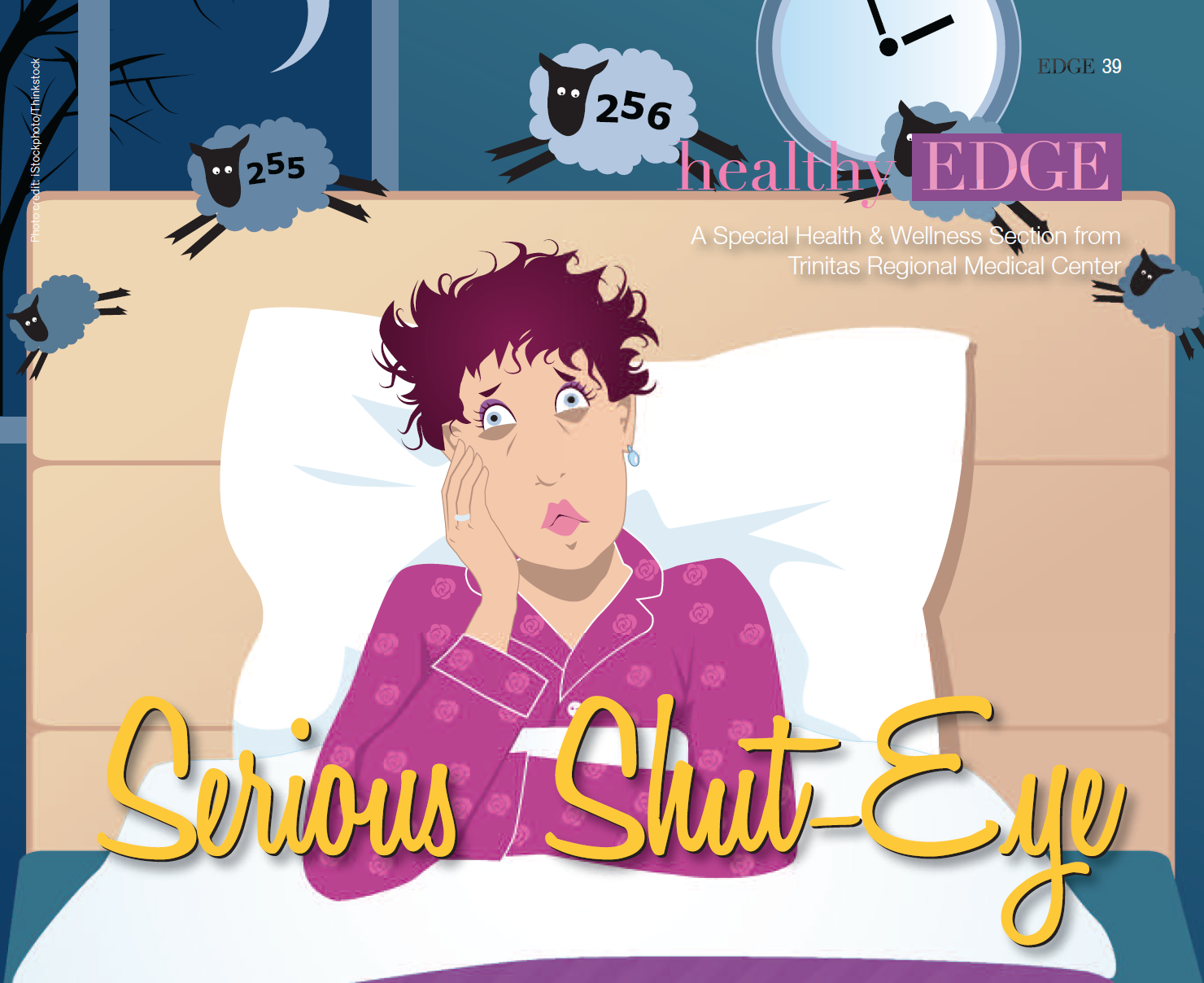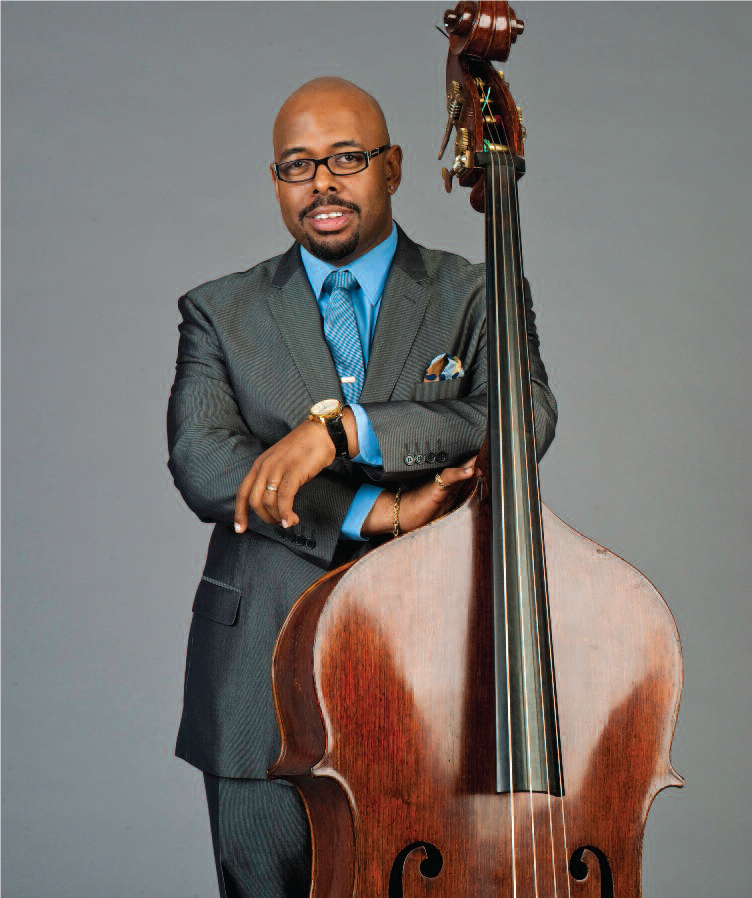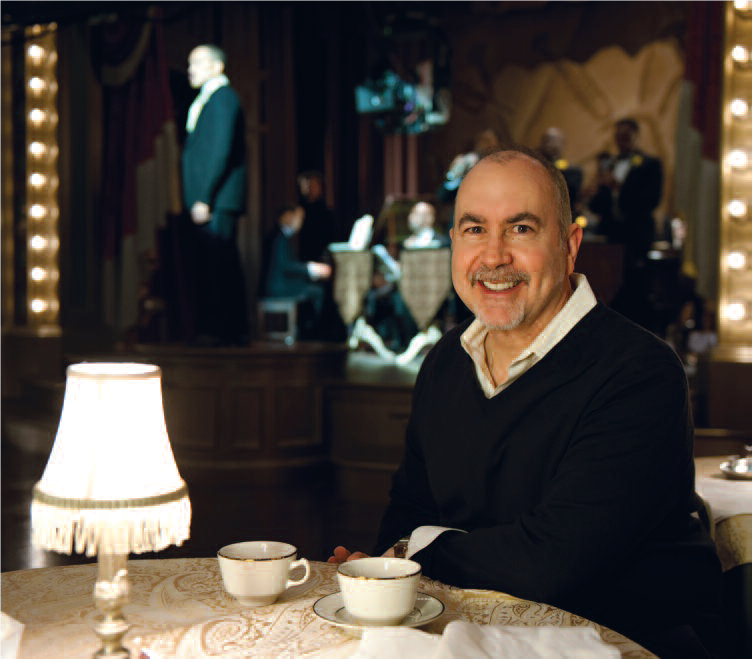

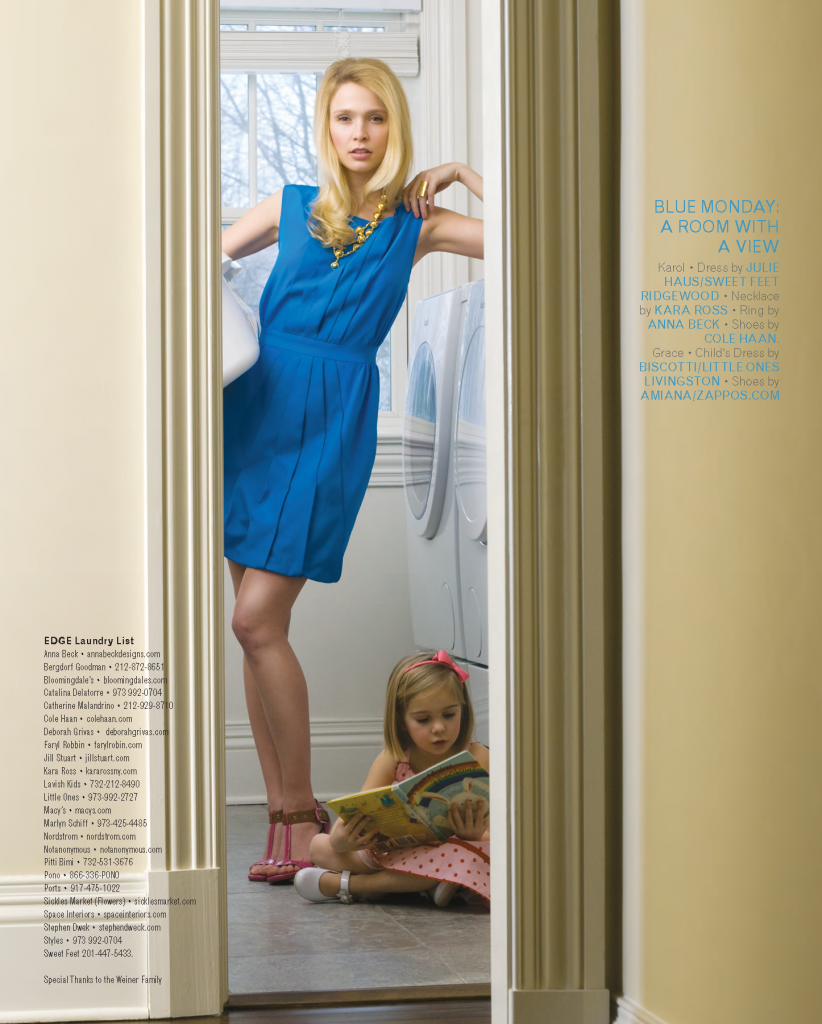






Timing is everything. NORMA KAMALI knows a thing or two about that. She shook up Madison Avenue in the 60s, put the first Pull Bikini on Christie Brinkley in the 70s, pioneered fashion video in the 80s and Internet shopping in the 90s. In 2008, Kamali launched what might just be the best-timed fashion line ever—a timelessly styled and budget- friendly collection for Wal-Mart. Her Spring 09 offerings are right on the money. Norma Kamali has always followed her own path. As this chat with EDGE confirms, she is at her best when her plate is full…and even better when it’s overflowing.
EDGE: Are you as excited about Michelle Obama as others in the fashion industry?
NK: I am. She is wearing affordable clothes. That is the best fashion statement.
EDGE: In a tough economy, sometimes you have to eliminate a couple of pricey items from your shopping list. What is the one thing a stylish consumer absolutely, positively cannot do without?
NK: If she is stylish, she really has everything, and doesn’t need anything else. However, styles at a price—and carefully chosen—can be a spirit-lifter. Anything expensive and not timeless might make you feel guilty or irresponsible.
EDGE: Last year you designed the costumes for Twyla Tharp’s ballet Rabbit and Rogue. What drew you to this project?
NK: I had worked with Twyla Tharp on a number of different productions. One being The Upper Room. Twyla came to me with the Rabbit and Rogue project as the evolution to this classic piece. The Upper Room is such a success. What drew me to this new project? It was the next wave of The Upper Room.
EDGE: What part of this production influenced you most during the conceptual process—the music, the movement, a dancer, a character?

Photo courtesy of American Ballet Theatre
NK: The concept of dark to light. The speed of the music. The type of music, film music. The music influenced the speed of the dance. Danny Elfman’s music came first and then these visual concepts. My concept for the costumes was to take the dark to light by using black, then silver, then white. I wanted to keep the color concept of silver from the beginning to the end. Brad Fields’s lighting design used the dark-to-light concept as well.
EDGE: Did Twyla coordinate your efforts?
NK: Yes. It’s a process. I would create a costume, the dancer would try it on, we’d tweak it, keep evolving it, until it worked. It’s a lot of fun, building on steps, like a painting or any creative project.
EDGE: Did you approach Rabbit and Rogue in a similar way to your runway shows and collections in terms of practicality? Drape, flexibility, breathbility, etc?
NK: Absolutely. First I figured the colors then I built on it. The way I approach something is to start, then edit and change, edit and change. The product just gets better and better that way. I would do a fitting and take photos with my IPhone. Twyla would look at them and write or call me back.
EDGE: Is designing costumes for a ballet different from designing for a musical on Broadway?
NK: I like dance a lot. It’s my preference. I’m not as excited personally with musicals or other Broadway forms. Other people do that really well. With dance I have an open palette. There’s a more creative spirit to it. It’s more fluid, less defined to a story line.
EDGE: You are a world-famous multi-tasker. What’s on your plate as 2009 starts to unfold?

Photos courtesy of Norma Kamali, Inc.
NK: Anything that relates to the new economy. I like to reinvent and think out-of-the-box.
EDGE: Can you sum up the inspiration for your Spring 09 line in a couple of words?
NK: Yes. Timeless style.
Editor’s Note: Special thanks to Leah Soltas for making this interview happen. To see Norma Kamali’s new collections log onto normakamali.com
Looking like a star is worth every penny
Heatproof Yourself Like the Stars
The allure and glamour of Hollywood is something that will always define and inspire stylish culture. When summer weather turns hot and heavy (and it certainly does here in New Jersey), droves of people flock to darkened cinemas more than any other time of the year. After a long, dehydrating day at the shore, there’s nothing better than settling into a big, comfy seat in a vaulted, air-cooled theater to watch your favorite flawlessly put-together movie star perform in front of the camera. That may well be the secret star quality of all big-screen idols—they always manage to look so cool, literally and figuratively.
You’ll never see George Clooney sweat, Kate Hudson’s t-zone get shiny, or Julia Roberts’s curls frizz. There’s no doubt that having skin, hair, and makeup experts on call for minute-by-minute touch-ups is essential for movie icons to stay camera-ready at all times. I myself, however, while shooting some scenes for my television show, have had to rely on my own quick fixes and ever-ready products to work their magic. After some arm-twisting, the EDGE editors have convinced me to divulge a few of my closely guarded secrets. The truth is, there are tons of ways to keep yourself in camera- ready condition (even when off-film).
The ones I have chosen to share with you will easily get you through any heatwave looking as flawless as Catherine Zeta Jones on her best day. Light hydration is key. Shy away from heavy moisturizers that in summer heat will transform that healthy matte finish on your skin into a shiny, mirrored surface. Instead, always keep an EVIAN MINERAL WATER SPRAY in your bag. Although this spray has been around forever, it’s still an industry staple that manages to keep skin looking supple, not slippery. The spray comes in a handy 5-oz. size and retails for around $10. When the heat and humidity get a little out of hand, it’s always a great idea to keep blotting sheets at hand. Although they say the camera adds at least 10 pounds, a sure-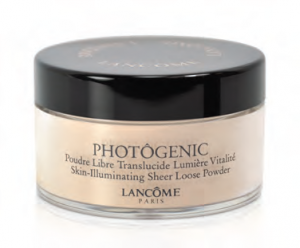 fire way to keep your face looking trim and contoured is to eliminate any shine. After shooting for eight hours in 103-degree, dense New Orleans heat, I found that DIOR’S BLOTTING PAPERS ($21) were a total and complete lifesaver.
fire way to keep your face looking trim and contoured is to eliminate any shine. After shooting for eight hours in 103-degree, dense New Orleans heat, I found that DIOR’S BLOTTING PAPERS ($21) were a total and complete lifesaver.
Not only do the sheets wipe away shine, they come with their own mirror and are treated with a light fragrant powder that adds a matte finish to even the most reflective of t-zones. As far as light makeup is concerned, PHILOSOPHY’S THE PRESENT ($25) is a true gift in any season, but particularly useful during summer. Made with natural antimicrobial agents, The Present literally forms a barrier over your skin that both locks in moisture and blocks out environmental impurities. Sound too good to be true? It’s not.
Simply rub a dime-sized portion of The Present on your clean face every morning before applying any other makeup and your skin will literally appear flawless all day long—I promise! As a final step to finish your face, most makeup artists recommend a quick brush-over with a loose powder. LANCOME’S PHOTOGENIC SHEER LOOSE POWDER ($32) is a dream come true. With a large blush brush, gently dust your face and neck with light powder, then follow up by blotting around your nose and under your eyes with CHANEL’S MAT LUMIERE foundation ($52). If, perchance, you spot a dreaded blemish, CHANEL’S PRO LUMIERE CORRECTEUR PROFESSIONAL FINISH CONCEALER ($38) is a quick and easy fix.
I shouldn’t have to tell you this but it’s worth a reminder: make sure your foundation and concealer perfectly match your skin tone. When choosing a base or cover-up, it’s critical to test the makeup against your skin in natural light. Fluorescent lighting can so drastically skew color perception that you just might end up looking more like Marcel Marceau than Marilyn Monroe. On a final note, hair has always caused the most problems for me personally on film. I’m one of those people with insane, schizophrenic hair—something like Zeppo Marx meets Alfalfa from The Little Rascals. While shooting,
I always keep a travel-sized can of L’OREAL ELNETT SATIN FLEXIBLE HOLD HAIRSPRAY ($16) on the set. The Elnett line is a hair lacquer that doesn’t overload the follicle with fragrance or dry it out with tons of extra alcohol. This particular spray manages to be light, yet nourishing with a bouncy, non-static hold. Believe me, if it can keep my hair in check, it will work wonders for you. By applying these simple cosmetic fixes and stocking up on the recommended products, you’ll be able to get yourself camera-ready in no time. Most importantly, remember that a natural, healthy glow is the order of each and every day. With these simple tips, you will easily put your best face forward through any heat wave. Keep your personality as light as your moisturizer and makeup and you’ll discover, soon enough, how to not shine…like a true star!
Editor’s Note: Dan Brickley was the host of TLC’s A Makeover Story for three seasons. He has authored numerous articles on fashion and beauty.


Atlantic City’s hottest hotels are sparing no expense when it comes to pampering their guests. The newest battleground for business is skincare—and the big winner may be you.

There is certainly something to be said about the soothing effects of being near the ocean. The air is cleaner. Breathing comes easier. Blood pressure, elevated by a hectic workweek, eases downward. For some, rejuvenation comes with a winning hand of Texas Hold ’Em. For others, the j ackpot is waiting at one of AC’s world-class spas, where skincare regimens play a major role in relieving the outward signs of stress—and the hotels leave little to chance. “We’re the newest spa in Atlantic City,” says Jane Mackie of the Chelsea Hotel’s Sea Spa. “The décor is retro—close to nature. There’s an opportunity to do natural and healthy treatments here.”
ackpot is waiting at one of AC’s world-class spas, where skincare regimens play a major role in relieving the outward signs of stress—and the hotels leave little to chance. “We’re the newest spa in Atlantic City,” says Jane Mackie of the Chelsea Hotel’s Sea Spa. “The décor is retro—close to nature. There’s an opportunity to do natural and healthy treatments here.”
Sea Spa offers a variety of facial and body treatments— everything from nurturing and strengthening delicate skin to nourishing and calming rough skin by deep-cleansing to a silky-soft texture. Sea Spa’s signature treatment is a full-body Mediterranean Veggie Wrap, which makes you feel good on the outside and actually nourishes you on the inside. Extracts found in a typical Mediterranean garden are blended to smooth, tone, and elasticize the skin. At the other end of the island, off White Horse Pike, is the 36,000-square foot Immersion (left), perched atop the awe-inspiring Water Club.
Brennan Evans is the Spa Director of this harmonious space where soothing water features and Asian-inspired elements and textures blend to provide an atmosphere of total tranquility. “Being close to the shore, it’s all about beautiful skin,” claims Evans. “We have skincare services that include the use of hyperbaric oxygen as an infusion method for transporting serums into the skin to help reduce fine lines and smooth pigmentation. This allows for immediate results with no down-time for recovery. Ayurvedic skincare treatments can be customized to your personal dosha through a simple questionnaire and mini-consult with our estheticians.”
Immersion also features stimulating body exfoliating and moisturizing sessions that take advantage of modern technologies such as heated hamman/vichy tables and cocooning dry-fl oat, soft-pack tables. bluemercury (below), founded ten years ago by Marla Malcolm Beck, is located in the Quarter at the Tropicana. The spa draws many clients who make special trips from New York, Philadelphia, and D.C. looking for resultsoriented treatments and products. Products such as Kiehl’s Shaving Cream, Bumble & Bumble Seaweed Shampoo, and Dermalogica Active Moist Moisturizer are best-sellers. “And given that we have the beach in Atlantic City,” says Beck, “sunscreens are always popular.” bluemercury recently added a new brightening facial to its menu. “An intense, vitamin C firming treatment,” Beck explains, “this facial is amazing because you come out feeling like someone just tightened your skin. I also adore our luxury body treatments, which are almost two hours of pure pampering and massage. Our ‘Coconut Escape’ is our most popular.” bluemercury also unveiled its first Ultimate Skincare Guide. “What we try to do,” says Beck, “is make sense of the world of skincare products, which can be quite confusing. There are informative sections about what certain ingredients, like vitamin C and vitamin A, really do.”
The guide is available to all visitors and also online at bluemercury.com. The 16,000-square-foot Qua Baths & Spa, located on the fourth floor of the Ocean Tower at Caesar’s, impresses the moment you enter its doors. As Robert Seibel explains, “We attack your senses immediately. Our concept is to have you leave all your problems outside.” Qua Baths & Spa features Organic Spa Therapies with a focus on eliminating toxins. The body itself does not produce most toxins, notes Seibel. Rather, they tend to come from poor habits such as an unhealthy diet, smoking, and excessive drinking—all of which destroy new cell growth. Ocean Sp ray Organic Treatments, including the Body Renewal & Detoxification Therapy, Organic Firming Massage, and Organic Facial, utilize key ingredients in sea salts and seaweed, which rank among the purest form of therapeutic organic substances. Seibel also shares with clients his concerns regarding certain skincare products. “Many facial products may smell nice, but many people, whether they know it or not, may be allergic to them.” He recommends the Spa’s Organic Facial, noting that it works for those with sensitive skin and folks wanting “something different.” Every day you leave the house, you’re rolling the dice when it comes to the health of your skin. So how ironic is it that the one place you can’t lose is the gambling capital of the East? Just another reason to adore New Jersey.
ray Organic Treatments, including the Body Renewal & Detoxification Therapy, Organic Firming Massage, and Organic Facial, utilize key ingredients in sea salts and seaweed, which rank among the purest form of therapeutic organic substances. Seibel also shares with clients his concerns regarding certain skincare products. “Many facial products may smell nice, but many people, whether they know it or not, may be allergic to them.” He recommends the Spa’s Organic Facial, noting that it works for those with sensitive skin and folks wanting “something different.” Every day you leave the house, you’re rolling the dice when it comes to the health of your skin. So how ironic is it that the one place you can’t lose is the gambling capital of the East? Just another reason to adore New Jersey.
Editor’s Note: For more information call Sea Spa (800) 548-3030; Immersion (800) 800-8817; bluemercury (609) 347-7778 and Qua Baths & Spa (609) 343-2400.

“The menu divined by Bucco is a coming together of contemporary cooking. He trends seasonal, adds a little local, and comes up with American Med as a core.”
It’s the late 1970s and there’s a small crowd at the bar of the venerable Ryland Inn, tucked back off the whoosh of cars on Route 22 in the Whitehouse Station section of Readington, in suddenly populated eastern Hunterdon County. There are fellows just in from jobs in New York, the 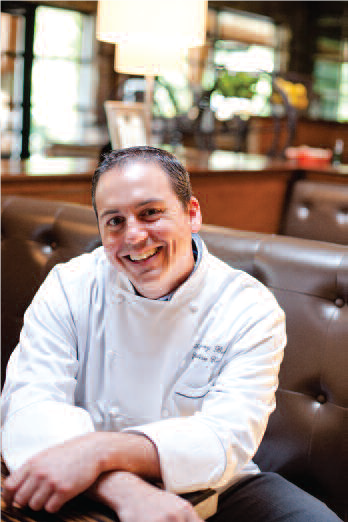 long commute to their new five-bedroom homes on two acres over for the day, there’s a smattering of casual dinner-seekers finishing burgers, there are journalists like me, in between night meetings, stopping in to catch the local gossip in a homey, low-key setting. That Ryland’s a roadhouse, a pitstop on the outskirts of suburbia. By the time it was purchased and re-imagined as a fine-dining destination, with Dennis Foy briefly installed as the name chef—a front man for then-little-known Craig Shelton—Readington and eastern Hunterdon had sprawled confidently into suburbia and many of the denizens in the immediate ‘hood (not to mention surrounding hunt country) were well-heeled and world-wise, ready for haute cuisine in an atmosphere to match, right in their backyards. The 1990s Ryland Inn delivered it all. Soon Shelton was on the cover of Gourmet magazine and the recipient of the food world’s equivalent of an Oscar, a James Beard Award. Ryland catered to the food cognoscente and captains of industry in a seamless operation that defied anything New Jersey had seen. Though its last years were rocky—and the flood that six years ago forced the inn to close was tragic—Ryland had made restaurant history in a state once better known for red sauce joints and boardwalk grub. The rebirth of the Ryland Inn a year ago, a vision realized by new owners Jeanne and Frank Cretella, with chef Anthony Bucco, gives us a very shiny new dining toy.
long commute to their new five-bedroom homes on two acres over for the day, there’s a smattering of casual dinner-seekers finishing burgers, there are journalists like me, in between night meetings, stopping in to catch the local gossip in a homey, low-key setting. That Ryland’s a roadhouse, a pitstop on the outskirts of suburbia. By the time it was purchased and re-imagined as a fine-dining destination, with Dennis Foy briefly installed as the name chef—a front man for then-little-known Craig Shelton—Readington and eastern Hunterdon had sprawled confidently into suburbia and many of the denizens in the immediate ‘hood (not to mention surrounding hunt country) were well-heeled and world-wise, ready for haute cuisine in an atmosphere to match, right in their backyards. The 1990s Ryland Inn delivered it all. Soon Shelton was on the cover of Gourmet magazine and the recipient of the food world’s equivalent of an Oscar, a James Beard Award. Ryland catered to the food cognoscente and captains of industry in a seamless operation that defied anything New Jersey had seen. Though its last years were rocky—and the flood that six years ago forced the inn to close was tragic—Ryland had made restaurant history in a state once better known for red sauce joints and boardwalk grub. The rebirth of the Ryland Inn a year ago, a vision realized by new owners Jeanne and Frank Cretella, with chef Anthony Bucco, gives us a very shiny new dining toy.
Today’s Ryland is posh, suave and ready for parties.  The outdoor entryway that leads to the indoor entryway just about shouts “Have your wedding here!” Once inside, vaulted ceilings, chandeliers that look like they were recycled from Liz Taylor’s diamond booty, fabrics and appointments hardly from the off-the-rack collections, and an air of mission accomplished set the scene for rarefied dining. Rather than a pretty charger plate that will be swept away shortly after you’re seated, there’s a framed picture at your place setting. Something old to add to all the new, I suspect. The Cretellas clearly wanted to bring every aspect of Ryland’s past to its high-toned present, and so there’s a sense of history in the artwork as well as in the Old-World graciousness of the well-orchestrated service. Come to Ryland to be pampered, once again.
The outdoor entryway that leads to the indoor entryway just about shouts “Have your wedding here!” Once inside, vaulted ceilings, chandeliers that look like they were recycled from Liz Taylor’s diamond booty, fabrics and appointments hardly from the off-the-rack collections, and an air of mission accomplished set the scene for rarefied dining. Rather than a pretty charger plate that will be swept away shortly after you’re seated, there’s a framed picture at your place setting. Something old to add to all the new, I suspect. The Cretellas clearly wanted to bring every aspect of Ryland’s past to its high-toned present, and so there’s a sense of history in the artwork as well as in the Old-World graciousness of the well-orchestrated service. Come to Ryland to be pampered, once again.
The menu divined by Bucco is a coming together of contemporary cooking. He trends seasonal, adds a little local, and comes up with American Med as a core. You can expect pears and pumpkin in fall, Jersey staples such as birds from Griggstown Farm and fish from Barnegat, and also luxe ingredients the revived Ryland wants attached to its name: foie gras, Berkshire pork, uni. The cavalcade of chi-chi ingredients punctuates the menu, some of them a tad out-of-date (squid ink, white anchovies), some of them more current (red quinoa, shishito peppers). You can go a la carte, you can go tasting menu; you will spend. All entrees are in the $30s, the least expensive starter a salad at $12. Indeed, the wine list struggles at the value end of the spectrum and could stand to be updated at the three-figure range as well with a smarter selection of artisan bottles. But we enjoy our splurge, cosseted as we are in the grand Polo Room, and dispatch a complimentary uni-custard with smiles. I’m feeling quite at home with the Jersey’d version of pasta carbonara, a tangle of squid ink chitarra with ultra-smoky Mangalitsa bacon, spirited Fresno chilies and a dot or five of uni.
It’s mod and classic at the same time and, most importantly, it’s delicious. So is the stately torchon of foie gras, swaddled with pears braised in vanilla and an onion jam I’d be happy to have for dessert. There’s even a dusting of chocolate crumbs to make my case for this starter as a most grand finale. The octopus done Spanish style is terrific, an assemblage of tender meat with crumbles of warming chorizo, those vivacious shishitos, real-deal black potatoes and a kick of zesty chimichurri. Bring it on, anytime. By contrast, the mild purée of fall vegetables is a bland option, but that isn’t to say this take on a stylish soup is uninteresting: with twirls of fennel fronds, a smack of fig jam and a sprinkling of pumpkin seed oil, it’s both comforting and appropriately warming. Our server tosses in an extra, a black olive cavatelli that strikes me as pure Sicily with its dressing of golden raisin puree kept in check by good, salty capers and buttery pine nuts. Just when I think Bucco is too reliant on sweet, he proves his mettle with a shot of the right balancing agent. The harissa-stoked tomato jam is as fine a friend as grilled swordfish can have, the sweet-hot condiment giving a needed tickle to the rich fish steak. I don’t think the red quinoa or eggplant on the dish did as spirited a two-step with the meaty sword, however.
But I love the way the chickpea panisse and riffs of white anchovies play off the steamed red snapper, and thought the spark of lemon basil and snap of skinny string beans kept pace with the plate. Pork belly, especially Hudson Valley Berkshire, took a liking to the cheerful crumb-like topping the folks here dub “granola,” and the tart apple and mild butternut squash accompaniments were just-right sides. Desserts trip the globe, but need reining in at times. The yuzu curd “truffle,” with astringent Asian pear, a sultry black sesame cake and green tea ice cream works a Far East theme nicely. But flavors warred in the frozen cranberry parfait, with pecan streusel, toasted marshmallow meringue and cloying pumpkin pie ice cream proving too much that’s too sweet isn’t a good thing. The central taste of cranberry was lost. Tamarind, however, was a uniting element in the peanut butter mousse ensemble that allowed specks of banana and dabs of Nutella to compliment, not cover up. Ryland, rebooted for an era that knows both unbridled luxury and forced restraint. Wow, I think as I leave the space I first set foot in 36 years ago. Lots of bucks have been put into this ol’ gal, and she’s looking mighty fine. Over the top? Maybe. But not out of sight.

In New Jersey, over-the-top gardening is no longer flying under the radar.
As forest and farmland have yielded to suburban sprawl, cities large and small across the country are reclaiming the urban landscape and becoming greener. Much of this green revolution is taking root high above street level, in the form of mini-parks and farms sprouting from the unlikeliest of places. Fueled by increased sustainability concerns and the burgeoning locavore movement, rooftop gardens are everywhere—out of sight but, increasingly, top of mind. Take our nation’s capital, for example. In 2012, Washington DC added 1.3 million square feet of rooftop garden space. From ancient times, when Nebuchadnezzar hung world-wonder gardens from the terraces of his Babylonian palace, rooftop gardens have captured our imaginations.
Even on a micro scale, what apartment dweller hasn’t tended herbs and potted tomatoes on a patio or fire escape? Well, now “agri-tecture” has become big business. In Brooklyn, rooftop farms are practically commonplace— beehives hum, chickens lay eggs, and organic vegetables begin their farm-to-table journey. The benefits of these Edenic aeries are manifold. Besides creating natural spaces and gardens, and optimizing space, the greening of roofs increase sustainability by reducing and reusing storm water, countering carbon dioxide, improving quality of life and the health of building occupants. To some, a green roof is a purpose; to others it is a passion. One extreme example is the Pasona, a human resource conglomerate in Tokyo. It’s headquarters is green inside and out with, a roof sprouting sweet potatoes, green interior and exterior walls, and a hydroponic rice-paddy foyer, which is harvested several times a year. The rooftop movement differs from country to country, and region to region, but make no mistake— it has definitely taken root here in New Jersey.


77 Hudson • Jersey City Installed by Let It Grow, of River Edge, NJ Four years ago, this rooftop garden was installed in Jersey City on an 11-story paring building structure between a KHovnanian condo high rise and an Equity Residential rental tower. This was a huge engineering feat, as much of the parkland material was installed by crane. Built on Styrofoam and two feet of fill on nearly an acre, it includes a pool, hot tub, dog run, African fire pit, children’s play area and even a landscaped hill. Undeterred when Hurricane Sandy struck and wind-stripped the soil (leaving roots exposed), the building replaced the landscape with heavier soils, planted more densely and installed a glass windshield. According to Randy Brosseau, KHovnanian Area President, it’s all worth it: “The garden adds a lot of value to our residents’ lives, whether using the facilities, enjoying the parkland or enjoying the view of the plantings. The green roof to many is a good reason to buy at 77 Hudson.”
 NJIT Cafeteria Garden • Newark Installed in 2010 by “My Local Gardener” with Peter Fischbach and Julie Aiello You can’t get fresher or healthier food than the vegetables that are served at NJIT’s cafeteria. For three years, NJIT students and faculty have enjoyed farm-to-table vegetables harvested from an elevated 220 sq. ft. organic roof garden outside the student pub. On an existing “green” roof—which already had a faucet—the design team installed 10 recycled flower boxes and filled them with a light soil that wouldn’t weigh down the roof. According to NJIT chef Peter Fischbach (right), who envisioned the project with Julie Aiello, Director of Marketing and Sustainability for Gourmet Dining Services (GDS), the campus food purveyor, they plant rotating crops of healthy vegetables four to five times a growing season, including lettuce, beets, tomatoes, squash, broccoli, kale, collard greens, Brussels sprouts, peppers and peas. They also grow a large selection of herbs, which are used to season the food. Meanwhile, the garden has germinated other campus organic gardens. According to Fischbach, “The project has been so successful that it has inspired other colleges serviced by GDS—Seton Hall, Manhattan College, Kean University, FDU in Madison. And we are preparing to put in a garden at Bloomfield College.”
NJIT Cafeteria Garden • Newark Installed in 2010 by “My Local Gardener” with Peter Fischbach and Julie Aiello You can’t get fresher or healthier food than the vegetables that are served at NJIT’s cafeteria. For three years, NJIT students and faculty have enjoyed farm-to-table vegetables harvested from an elevated 220 sq. ft. organic roof garden outside the student pub. On an existing “green” roof—which already had a faucet—the design team installed 10 recycled flower boxes and filled them with a light soil that wouldn’t weigh down the roof. According to NJIT chef Peter Fischbach (right), who envisioned the project with Julie Aiello, Director of Marketing and Sustainability for Gourmet Dining Services (GDS), the campus food purveyor, they plant rotating crops of healthy vegetables four to five times a growing season, including lettuce, beets, tomatoes, squash, broccoli, kale, collard greens, Brussels sprouts, peppers and peas. They also grow a large selection of herbs, which are used to season the food. Meanwhile, the garden has germinated other campus organic gardens. According to Fischbach, “The project has been so successful that it has inspired other colleges serviced by GDS—Seton Hall, Manhattan College, Kean University, FDU in Madison. And we are preparing to put in a garden at Bloomfield College.”
Revel • Atlantic City Installed by Cagley & Tanner of Las Vegas Last summer, Revel, the upscale resort in Atlantic City, opened a two-acre Sky Garden to recall the beauty and ambiance of the great Atlantic seaside resorts of the past—following the practice of situating a resort in a garden that descends to the beach. While the hotel’s architecture is 21st century, the designers sought to enhance the vista with a mix of nostalgia and modern ingenuity. This homage to the lawns that swept down to the ocean begins, in fact, at 114 feet above sea level, and is landscaped for seasonal interest—with 20,000 plants ranging from native sea grasses to Japanese Black Pines that create a Pine Grove surrounding an outdoor fireplace. (Planting the large pines required creating a deep recessed area under the roof surface to allow for root growth.) Their hard work paid off, as the garden successfully weathered the forces of Sandy.
Extra Space Storage • North Bergen Extra Space Storage, with its landscaped roof, definitely wins the “good neighbor award.” While only the on-site manager has access to Extra Space Storage’s rooftop garden, the company installed the nearly half-acre landscaping to “ensure an aesthetically pleasing view for all for the high-rise condo properties that surround our building,” explains Clint Halverson, Vice President for Corporate Communications and Investor Relations. The mechanics of creating a rooftop garden involve a number of variables: structural support, irrigation, installation stories above ground level, wind buffers and— not the least of concerns—waterproofing, root barriers and drainage. However, the rewards also are significant. Gardens insulate, reducing heating and cooling costs up to 30%. And they shield a building from urban noise. In the end, though, the greatest selling point of a rooftop garden is its aesthetic and recreational appeal. In a world of concrete, glass and steel, we welcome anything that speaks so eloquently to our senses and spirit.
Editors Note: Sarah Rossbach is the author of Feng Shui: The Art of Chinese Placement, which was described by The New York Times as the “bible of the practice.”
The Big Build Up

Photo credit: iStockphoto/Thinkstock
Is there a second story in your future?
Moving up doesn’t have to mean moving out. More and more, owners of one-story dwellings in the Garden State have been addressing their space issues by adding a second floor. Yes, it’s expensive. And yes, it’s messy. But in many cases, “building up” makes more sense than shopping for a new home. There are any number of reasons to add a second story to your current home but, needless to say, they are all related to space. The big question is Why go through the time and trouble to do so if you could just buy something that suits your needs? Well, for starters, that would mean having to put your own (presumably undersized) house on the market for sale, or as a rental property. So there’s a major hassle factor. Also, you may be locked into a great mortgage rate in your current abode, or for some reason be unable to qualify for a favorable rate on a new property.
The most common answer to Why build up? is that you love your home, your neighborhood and your neighbors, and are willing to put up with the inconvenience in order to stay put. From an architect’s perspective, the primary challenges of designing a new home involve understanding a wide range of variables, and then reconciling them with the desires of the homeowner. The most cost-effective solution almost always involves using the existing foundation and exterior walls. A talented architect, working in concert with a structural engineer, should be able to check off most of the items on your list. For older homes—or homes that were constructed cheaply to begin with—there are going to be structural issues. However, rarely are they insurmountable. Hopefully, the solutions won’t bust your budget. Consulting with that structural engineer is a must. Understanding local building codes is obviously important, too. You’d be surprised to see what’s on the books in your town when it comes to staircases, ceiling heights, and room dimensions. The engineer sho uld also be able to tell you with absolute certainty whether you can get the job done without tearing out your first-floor ceilings. This greatly reduces the mess and expense. From a builder’s perspective, adding a second story isn’t all that different than building from the ground up.
uld also be able to tell you with absolute certainty whether you can get the job done without tearing out your first-floor ceilings. This greatly reduces the mess and expense. From a builder’s perspective, adding a second story isn’t all that different than building from the ground up.
In most cases, the addition fits neatly atop the current first floor, and uses the existing exterior walls as the primary support. In some cases, a modular addition can be employed, which offers significant savings. It’s partially assembled on the ground and then lifted into place with a new roof, or under your existing one. The interior finishing work is not all that different than any other home remodel job. From a realtor’s perspective, it usually makes sense to find something with more space in the same neighborhood. Especially in depressed markets, finding more space is cheaper than creating it. Of course, that generates a couple of potential commissions, but the facts do bear out this position. The addition of a second story rarely recoups the investment when it’s done. On average, in suburban areas, at least, the number seems to be around two-thirds. In other words, a $150,000 second-story addition may only increase your home’s value by $100,000. This is math you may be willing to live with, but it’s math you should do (with a competent and trusted realtor) before going all-in. Among the classic mistakes homeowners make is assuming their current attic construction will support a second floor. It almost certainly won’t.
Attics are not built to handle second-story traffic. There is no cost savings to be had here—it’s not as simple as simply raising the roof and converting gloomy storage space into a bright and airy second story. Also, that attic staircase you’d planned on repurposing is unlikely to pass muster with local building codes when it connects the two new living spaces. If you do not currently have a staircase in your home, keep in mind that it will have to go somewhere on your first floor—and that you may lose a room. Speaking of which, the plumbing, electric, heating and air conditioning systems that serve your first floor will need a lot more space on the first floor to make it up to the second floor. Some homeowners end up opting for an entirely new and separate set of systems for the addition. Keep in mind that part of the expense of adding a second story almost includes a new furnace, AC unit and water heater. Another consideration is what you’ll need to do to the exterior of your home to make it come together. That re-siding project you’ve putting off the last few years? Now’s the time to squeeze the trigger.
Y ou should also think about pulling together the interior. Indeed, a less common but still-critical mistake homeowners make is failing to really think through how the new second story will relate to the “new” first story in terms of how the entire home is used. Moving bedrooms to the second floor opens up all sorts of possibilities on the main level. If you determine how you might be using the first-floor space in the future, you can leave yourself a lot of options, especially if a new kitchen is part of the long-term plan. When it’s all said and done, a basic second-story addition will eat up a half-year of your life and cost you at least $125 to $150 per square foot, soup-to-nuts, plus professional fees. Depending on your desired finishes and a handful of other variables, the price tag of a 1,000-foot addition is likely to be in the neighborhood of $150,000. Does that make sense in your neighborhood? Ultimately, that’s a call you’ll have to make.
ou should also think about pulling together the interior. Indeed, a less common but still-critical mistake homeowners make is failing to really think through how the new second story will relate to the “new” first story in terms of how the entire home is used. Moving bedrooms to the second floor opens up all sorts of possibilities on the main level. If you determine how you might be using the first-floor space in the future, you can leave yourself a lot of options, especially if a new kitchen is part of the long-term plan. When it’s all said and done, a basic second-story addition will eat up a half-year of your life and cost you at least $125 to $150 per square foot, soup-to-nuts, plus professional fees. Depending on your desired finishes and a handful of other variables, the price tag of a 1,000-foot addition is likely to be in the neighborhood of $150,000. Does that make sense in your neighborhood? Ultimately, that’s a call you’ll have to make.

Dolce Publishing, Inc.
Series television, almost by definition, thrives on over-the-top characters. Yet the actors who land these coveted roles often stand out by underplaying them. It’s a brave, sometimes risky choice that requires trust on the part of the audience, director and fellow actors. Sofia Milos has made a career out of earning that trust. Her relationship with the camera transcends pure physical appeal and brings depth and nuance to her roles. As EDGE Editor at Large Tracey Smith discovered, what you see on the screen with Milos is just an intriguing tease for what you get.
EDGE: The characters you’ve played tend to project a blend of feminine vulnerability and powerful independence. Is that a European thing?
SM: I think it is partly my very European upbringing, and partly my living here in America. It has brought me to what seems rare sometimes among actors. Typically, either you’re just an artist and not a businessperson, or a businessperson and not a creative person. I enjoy both sides equally. So the characters I tend to play are nuanced women where there is this great sensitivity and passion—very European—but also independent, strong and powerful women in high-ranked positions. Like Homeland Security Special Agent Bianca LaGorda in The Border, my Canadian show. Or Yelina Salas on CSI Miami, whose role changed several times over the years, from detective to undercover cop to private investigator. Or Annalisa Zucca, a mafia boss, in The Sopranos. And quite a few more strong women like that.
EDGE: You were raised in Italy, educated in Switzerland, and then moved to New York. That’s quite a combination.
SM: Yes. And I came here at a young age. I was 19 when I first hit the ground in New York. This is really the land of opportunity. You’re given a chance here no matter what race you are, no matter what gender you are. In Italy, it wasn’t like that at the time. An Italian woman? Are you kidding me? You aren’t supposed to leave the house until you’re ready to get married! Here, I was given the opportunity to find myself and explore things I liked and through that I became very empowered. That empowerment, I think, it shone through in the roles that I picked and did best with.
EDGE: In The Sopranos, you went toe-to-toe with Tony as a female mob boss.
SM: James Gandolfini. I remember him so fondly. For a man this big and so important, playing a mafia boss, he was just a big teddy bear. Truly, he made it so wonderful to work with him. Each of the three episodes that I did, I had a great time. We had some long hours—18-hours a day—and you wouldn’t feel it. I had the best time working on those scenes. I was extremely sad when I heard he had left us—and on top of that in my city, in Rome.
EDGE: How did you work with David Chase?
SM: I was so grateful to have gotten that role, and grateful for his very particular, precise, concise requests, even on how much accent he wanted (laughs) coming from an Italian. He had an exact idea of what he wanted, yet I loved the freedom he gave me. To bring in those silent moments, those silent communications—he loved it and he let me do it!
EDGE: In a way, those Sopranos episodes were a turning point for you.
SM: They changed my career. Instead of having a 70 percent male audience, I suddenly had at least a 50 percent female audience. Women were saying Thank you for that character. Women are very, very strong. They always have been. They have been suppressed by cultures, religion, marriage, fears, customs of different countries, education—but I believe they are much more courageous than their male counterparts. I’d always thought of myself as a strong person, coming to the United States alone as a teenager, tapping into that strength, going out as a warrior while holding on to my traditions. All those things came through for the first time with Annalisa, this traditional Neapolitan, who was very strong and could go toe-to-toe with a mafia boss.
EDGE: How did you prepare for that role?
SM: Tim Van Patten, the director, gave me a book called Women and the Mafia, and I loved it. These were some brilliant, brilliant women, just on the wrong side of the law. I learned the difference between La Cosa Nostra, which is the Sicilian mafia, where the women would be quiet, didn’t see anything, hear anything, don’t talk, and the Camorra, the Neapolitan mafia. If the husband dies or is incarcerated in the Camorra, they are next in rank, and they take over. So Annalisa Zucca took over. That’s what she is, her husband. That infamous scene where she goes eye-to-eye, nose-to-nose, lip-to-lip with Tony Soprano and says Bleep you, you’re gonna have to deal with me!—that was the beginning of the fire between them. If Fifty Shades of Grey had existed back then, he would’ve called me Mrs. Zucca (laughing) and I would’ve called him Mr. Soprano!
EDGE: On CSI Miami, how much of Yelina Salas was you, and how much came out of character research?
SM: It was both. Understand that when you come on board a series and sign a contract for seven years, whether it lasts or not, there has to be a big part of you in the character. You are potentially in 20 or more episodes a year. You’re an actor. You have to bring that character to life, even if it’s very far from you. But you also bring something that is yours—your mannerisms, your looks, your little ways of doing something. As far as Yelina, I think the silent and unspoken moments—having a dialogue with your eyes—that was me, very Mediterranean. I’m very grateful for the “silent dialogue” between Horatio and Yelina. People enjoyed that very much, even though CSI Miami was a very fast-paced show. You know, I think that’s a difference between European movies versus American movies. In Europe, there are brilliant silent spoken moments, but overall perhaps the writing here enables actors to work more within the dialogue. I just thank God for all the amazing writers out there. They make my job easy.
EDGE: CSI Miami ran for 10 seasons. That’s extraordinary when you think about it. The show had a lot of moving parts.
SM: It was a brilliant, topical, creative, very aesthetic, choreographed show that required a solid team—from the wardrobe, to the lighting, to the writing, to the performances. I think they did a wonderful job on the clothing. The costume designer was amazing, and at least a couple of times a month I would just ask if I could buy the Dolce & Gabanna suits that my character wore, because I loved them and they fit so perfectly. Obviously she was a well-paid detective. I loved her style. You fit the glove, Sofia (laughing) or the glove fits you!
EDGE: You mentioned European films. As a fan of the movies, if you could jump into a time machine and slip into a classic role, which would it be?

H Magazine
SM: Marriage Italian Style with Sofia Loren and Marcello Mastroianni. I thought they were brilliant together. They were the epitome of brilliance. There was so much strength in her character, Filumena—so much pain, passion, attraction, history—to me it was a very ageless role that you could relate to in so many ways, and not just because of the way it was written. I actually have played Filumena, under the guidance and study of Milton Katselas at the Beverly Hills Playhouse. We put up some pieces in our master class and one was from Marriage Italian Style. I received a standing ovation as Filumena. That role had so many facets. It’s a role that I really loved.
EDGE: Elaborate a moment on your work with Milton Katselas. His students read like a Hollywood Who’s Who— including George Clooney, Alec Baldwin, Michelle Pfeiffer, Ted Danson…
SM: I was just so fortunate and blessed to have gotten to study with the Beverly Hills Playhouse under his guidance. He squeezed a lot out of us. He really pushed us. He brought us to our knees and then up to the clouds and then to the sky. He “let us have it” so that we could have it.
EDGE: You filmed an episode of Friends before it was even on the air. Did you sense that it had the makings of a hit TV show?
SM: I knew it. I could see that it was a tight family. They were so much fun, so down-to-earth, so willing to give each other freedom. Nobody had an ego, at least when I worked there.
EDGE: How did that ensemble cast differ from The Sopranos cast?
SM: In terms of teamwork, they didn’t, actually. The same thing was true on Curb Your Enthusiasm. Of course, that was an unscripted show, so you got the freedom to bring whatever and it was appreciated. On The Sopranos— especially the ten days in Naples—the whole cast was giddy, singing Italian songs. Seriously, the shortest day was 12 hours and the longest day was 20 hours, but you didn’t feel it. It was great. I had an amazing time.
EDGE: You’re pretty comfortable with different languages and dialects. Is there one you could never quite nail?
SM: No, because I don’t give up until I have succeeded. I can be very tenacious. I am currently studying Hebrew, and you’d think it’s a very difficult language, but after having only studied for a few months, I can have a simple conversation. It doesn’t seem so hard to me.
EDGE: Could you do a Scottish accent?
SM: For you? Now? Nope! (Laughing) But I do like Scottish men!
EDGE: What do you feel defines you as an actress?
SM: When I began in this business, I decided I wanted to have a choice of what I do—and that I would always maintain my integrity. Integrity ranks higher than anything to me. It’s my way of being selfish. I won’t compromise it. My dream would be to have so many offers that I could always be a working actress, yet still have integrity in everything I do. And always feel like OMG am I getting paid to do my hobby? If you talk about freedom in this business, real freedom is the ability to have clean hands. Is it a Hollywood thing to do? Maybe not so much. But it’s a Sofia thing to do.
I’m so tired, I haven’t slept a wink… I’m so tired, my mind is on the blink.

Photo credit: iStockphoto/Thinkstock
Beatles aficionados will recognize these lyrics from the Let It Be album. Truth be told, the group’s weary words should resonate with anyone who has ever been sleep-deprived for more than a night or two. The fact is, we’ve all been there—from punching the snooze button for an extra five minutes, to skipping that 5:45 a.m. spin class in hope of additional Zs, to heading straight for the couch after a long workday. So why is feeling fatigued so common? Why is having a healthy sleep so important? And what would be the downside if we just let it be? Health and sleep are inherently intertwined. Sleeping is a regenerative process for both the mind and body. A sufficient amount of quality slumber helps to maintain a healthy heart, metabolism and endocrine system.
Since most of us spend one-third of our lives buried in a pillow, it is important to have healthy and consistent sleep on a regular nightly basis. For some, however, nights featuring the cardinal eight hours are few and far between. According to the National Heart, Lung and Blood Institute, about 70 m llion people in the U.S. have a sleep problem and 40 million of these are chronic problems. Maybe you are a habitual snorer; you wake in the night and have difficulty falling back asleep; you’ve gained a significant amount of weight in the past year; or you kick during sleep. All of these symptoms and more can be associated with sleep disorders, though they are often under-diagnosed. All are curable. If left untreated, however, they can lead to serious health issues. Insomnia (the inability to fall asleep or stay asleep), for example, results in loss of concentration, reduced productivity and poor alertness.
Over time, insufficient sleep creates chaos within metabolic hormones, which can lead to obesity and diabetes. Sleep Apnea (breathing stoppage and diminished oxygen levels) can affect one’s blood pressure, heart and brain. It can lead to serious cardiovascular complications, including hypertension and strokes. While sleep disorders are prevalent in adults, they are increasing for children. If untreated, children may experience emotional, behavioral and learning disorders. As with most diseases, the symptoms triggered by sleep disorders can escalate over time. That being said, not all sleep-related difficulties are actually classified as disorders. There are many modifications that can be performed to improve sleep habits, such as shortening naps, avoiding caffeine and alcohol, and fixing a bedtime and wake-up time.
SEEING A SPECIALST If making a few lifestyle changes doesn’t do the trick, the next move is seeing a sleep specialist and undergoing a sleep study, which can diagnose and ultimately cure the disorder. Unfortunately, many people shy away from submitting to this type of procedure. They picture themselves in a bleak hospital sub-basement, on an uncomfortable cot, with wires connecting them to a bank of machines. The reality is quite different. At the Trinitas Comprehensive Sleep Disorders Center, for example, homey bedrooms await the troubled sleeper. The state-of- the-art facility offers monitored diagnostic sleep studies that are designed to quickly reveal the disorder. Trained sleep specialists and technicians work together on each study and conduct follow-up appointments with a subject’s physician. All cases are reviewed by Dr. Vipin Garg, the center’s Medical Director. Dr. Garg is board- certified as a Sleep Specialist, as well as in Pulmonary Medicine, Critical Care and Internal Medicine.
One of the center’s goals is to make patients feel as comfortable as possible during their stay. The center on the TRMC campus consists of four bedrooms—each with a personal bathroom and television and other amenities. To fulfill the growth and demand for more space, the center expanded to the Homewood Suites by Hilton in Cranford early in 2010. There are now two fully equipped bedrooms at this property. Dr. Garg notes how important it is to feel comfortable and at ease during a sleep study in order to gather the most helpful results. “The psychological mind-state of sleeping in a center is not the same as being at home,” he explains. “We try to make it feel as if you are in a hotel, rather than a hospital. We have access to all resources from the hospital’s many departments, and facilities at the hotel are extended to patients, including breakfast and the gym.” Sleep studies and treatment provided at the center are personalized for each type of sleep disorder. The staff is certified and trained in many disciplines and an array of treatment options is available.
If the problem is neurological, a neurologist will meet with the patient. For breathing issues, a pulmonologist will be present. If significant weight-loss is deemed beneficial to a sleep apnea patient, dieticians and surgery options are at hand. All sleep disorders are curable and patients have the opportunity to choose from treatment types. For example, if diagnosed with sleep apnea, depending on the case, one can undergo surgery for tonsil removal or sleep with a CPAP machine, which delivers additional air through the nose.
ONE NIGHT ONLY Typically, a single night of monitoring can result in a lifetime of quality sleep. The process is simple. Patients are instructed to do what they would typically do before any night of sleep, to ensure regularity and comfort, such as reading or watching TV. Patients are hooked up to leads that measure eye and leg movement, heart rate, airflow measurements and more—all while specialists watch the sleep behavior on video monitors. After roughly one week, the patients are asked to come back, results are reported and treatment  arrangements are made. For those who cannot (or will not) leave home to participate in a study, Dr. Garg proposes an alternative possibility: an at-home sleep study, using a new portable device that collects the same useful data. Success stories are hardly few and far between at Trinitas Comprehensive Sleep Disorders Center. On the contrary, the center conducted nearly 1,500 studies in 2012, including adults and children. One of Dr. Garg’s favorite stories concerns an eight-year-old boy, who was prescribed ADHD medication after meeting with a psychiatrist and pediatrician for hyperactivity and inattention in school.
arrangements are made. For those who cannot (or will not) leave home to participate in a study, Dr. Garg proposes an alternative possibility: an at-home sleep study, using a new portable device that collects the same useful data. Success stories are hardly few and far between at Trinitas Comprehensive Sleep Disorders Center. On the contrary, the center conducted nearly 1,500 studies in 2012, including adults and children. One of Dr. Garg’s favorite stories concerns an eight-year-old boy, who was prescribed ADHD medication after meeting with a psychiatrist and pediatrician for hyperactivity and inattention in school.
The boy’s mother mentioned his nightly snoring to the pediatrician, who recommended a sleep study. Dr. Garg diagnosed a severe case of Obstructive Sleep Apnea. After addressing the apnea, the ADHD medications were no longer needed, the boy’s performance in school drastically improved, and he became more energetic after losing weight. “The importance of sleep is an issue that has been previously ignored,” Dr. Garg laments. “Many times an internist fails to realize sleep disorders may be the problem at hand, because different questions are asked during a physical than during a sleep study. The impact of a sleep study is huge. It is a very natural, non-invasive process with no known side effects. The technology is getting better day by day, and we have had a lot of success.” Healthy sleep is imperative for us as individuals. By diagnosing and treating a sleep disorder, future serious issues can be avoided. The Trinitas Comprehensive Sleep Disorders Center is one of many centers that can help in the journey of pursuing quality sleep habits. Don’t let it be. If you are experiencing sleep difficulties, talk to your physician or sleep specialist about a center near you, and get on the road to a dreamy recovery.
Editor’s Note: The Trinitas Comprehensive Sleep Disorder Center is accredited by the American Academy of Sleep Medicine. It is located at 210 Williamson St. in Elizabeth. For more information, call 908.994.8694 or log onto njsleepdisorderscenter.com.
Six Gifts that Keep on Giving
Getting your over-50 friends and family members into the exercise groove is tough, but what if you gifted a gadget that made the experience more engaging and fun? Here are a half-dozen innovative and practical gift ideas that can jump-start a new post-holiday fitness routine…
• The Striiv Pedometer not only counts your daily walking steps, it sets up challenges for your routine and lets you earn points for your achievements. The folks at Striiv design personalized challenges tailored to your activity levels, and turn 10,000 steps a day into playing a game, donating to charity and competing with friends.
• For practical health, Fitbit’s Aria Scale doesn’t just measure your weight (which, FYI, isn’t the truest measure of health)—it also measures body mass index and body fat (which are more revealing). The information is transmitted wirelessly to your computer and assists in making  sure you are on-track to reach your goals.
sure you are on-track to reach your goals.
• Tired? The adidas Energy Boost Running Shoe boasts micro cells embedded in the sole engineered to return energy with each step you take. Runners’ World magazine gave the shoe high marks.
• Creativity keeps things interesting with the Zombies, Run! smartphone app. As you run or walk, the narrator gives instructions to dodge zombies and other threats. Novelist Naomi Alderman provides the storyline here— the website promises “you will go on an epic adventure that motivates you to run further and faster than ever before.” Better than having your brains eaten, right?
• For a more serene app, try Pocket Yoga, which lets you follow yoga routines from anywhere. An extensive library demonstrates everything from downward-facing dog to warrior. The nice thing about the app is that it allows you to create your own yoga routine, rather than forcing you to adhere to an instructor’s “most liked” poses.
• Swimming is one of the best activities you can do for your body! It’s easy on the joints and involves nearly every muscle, all while working your heart and lungs. There’s also a meditative rhythm to swimming steady laps. The problem is that swimming can be a bore at times. FiNIS SwiMP3 Headphones transmit music through your cheekbones and are fully submersible. Long-distance swimmers can even listen to audiobooks and podcasts.

For many people 50 and over, exercising sporadically just isn’t cutting it in terms of helping to maintain a healthy body mass index, or a strong heart and lungs. These are what I like to call our 30 bonus years…let’s use technology to keep our bodies in sound working condition so we can rise to the physical challenges that potentially await us later in life.
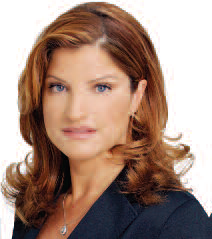 Editor’s Note: Gerontologist Alexis Abramson, PhD appears frequently as an on-air expert for NBC’s Today show, and also on CNN, CBS and MSNBC. Her commitment to baby boomers and mature adults has been featured in TIME, Forbes, The Wall Street Journal, People and other national publications. To see more of her thoughts on aging gracefully (and intelligently), log onto alexisabramson.com.
Editor’s Note: Gerontologist Alexis Abramson, PhD appears frequently as an on-air expert for NBC’s Today show, and also on CNN, CBS and MSNBC. Her commitment to baby boomers and mature adults has been featured in TIME, Forbes, The Wall Street Journal, People and other national publications. To see more of her thoughts on aging gracefully (and intelligently), log onto alexisabramson.com.
News, views and insights on maintaining a healthy edge.
 Flip-Flopping in the Classroom The back-to-school season always holds some surprises for educators, kids and parents. This year, many noticed a rise in foot pain among returning students. The popularity of cheap, stylish flip-flops has more than a little to do with this, according to the American College of Foot and Ankle Surgeons. Right into the mid-teens, kids have new bone growing in their heels. Flip-flops offer no support or cushioning for this part of the foot, and summer-long repetitive stress can manifest itself in pain and injuries once students switch back to traditional school footwear. If your child is experiencing pain, it’s important to explore an immediate remedy—stretching exercises, ice massage, anti-inflammatory medications, and custom or over-the-counter shoe inserts are certainly worth exploring. Obviously, if the pain worsens or persists, a visit to the podiatrist is called for.
Flip-Flopping in the Classroom The back-to-school season always holds some surprises for educators, kids and parents. This year, many noticed a rise in foot pain among returning students. The popularity of cheap, stylish flip-flops has more than a little to do with this, according to the American College of Foot and Ankle Surgeons. Right into the mid-teens, kids have new bone growing in their heels. Flip-flops offer no support or cushioning for this part of the foot, and summer-long repetitive stress can manifest itself in pain and injuries once students switch back to traditional school footwear. If your child is experiencing pain, it’s important to explore an immediate remedy—stretching exercises, ice massage, anti-inflammatory medications, and custom or over-the-counter shoe inserts are certainly worth exploring. Obviously, if the pain worsens or persists, a visit to the podiatrist is called for.
 Follow-Up on NYC Soda Ban New York’s short-lived soda ban spurred a slew of studies on the actual impact of obesity-focused legislation. A recent article published in the American Journal of Agricultural Economics suggests that strategies such as taxing sugary beverages would not reduce obesity, because consumers would simply switch to un-taxed options. Public health advocates have posited that higher prices would deter unhealthy food purchases. But according to research economists, that simply isn’t the case. In New York, a court ruled that the Board of Health exceeded its authority in instituting the ban, which was pushed by Mayor Michael Bloomberg. Among the criticisms of an “obesity tax” is that it would target lower-income consumers who tend to buy more high-calorie foods and beverages, and thus would be a regressive tax. Even so, the search for a “social solution” will continue; more than a third of U.S. adults, and one in six children, are technically obese. The medical costs associated with obesity are between $125 and $150 billion a year.
Follow-Up on NYC Soda Ban New York’s short-lived soda ban spurred a slew of studies on the actual impact of obesity-focused legislation. A recent article published in the American Journal of Agricultural Economics suggests that strategies such as taxing sugary beverages would not reduce obesity, because consumers would simply switch to un-taxed options. Public health advocates have posited that higher prices would deter unhealthy food purchases. But according to research economists, that simply isn’t the case. In New York, a court ruled that the Board of Health exceeded its authority in instituting the ban, which was pushed by Mayor Michael Bloomberg. Among the criticisms of an “obesity tax” is that it would target lower-income consumers who tend to buy more high-calorie foods and beverages, and thus would be a regressive tax. Even so, the search for a “social solution” will continue; more than a third of U.S. adults, and one in six children, are technically obese. The medical costs associated with obesity are between $125 and $150 billion a year.
 Drug Wonder Downunder A pair of Australian medical researchers have been recognized for their breakthrough work with Duchenne Muscular Dystrophy, a condition caused by mutations in the dystrophin gene on the X chromosome—which means it mostly affects boys. DMD patients are wheelchair-dependent by age 12 and often don’t survive past their early 20s. The researchers have developed a drug that works by skipping over the faulty part of the gene, producing a functional version of the protein dystrophin. This protein stabilizes the muscle fiber during muscle contraction. Without dystrophin, muscle fibers are replaced by scar tissue. In clinical trials, boys on the drugs have been walking up hills, operating pedal cars and whistling after 90 weeks. “It is extremely exciting to see that genetic testing is finally coming to the forefront of clinical medicine,” says Dr. Kevin Lukenda, Chairman of TRMC’s Family Medicine Department. “For years, this information was limited to research and academia. With a simple swab of a patient’s saliva in my office, we can detect over 30 possible genetic mutations within an individual’s DNA. This is the future of early diagnoses and treatment in clinical medicine.”
Drug Wonder Downunder A pair of Australian medical researchers have been recognized for their breakthrough work with Duchenne Muscular Dystrophy, a condition caused by mutations in the dystrophin gene on the X chromosome—which means it mostly affects boys. DMD patients are wheelchair-dependent by age 12 and often don’t survive past their early 20s. The researchers have developed a drug that works by skipping over the faulty part of the gene, producing a functional version of the protein dystrophin. This protein stabilizes the muscle fiber during muscle contraction. Without dystrophin, muscle fibers are replaced by scar tissue. In clinical trials, boys on the drugs have been walking up hills, operating pedal cars and whistling after 90 weeks. “It is extremely exciting to see that genetic testing is finally coming to the forefront of clinical medicine,” says Dr. Kevin Lukenda, Chairman of TRMC’s Family Medicine Department. “For years, this information was limited to research and academia. With a simple swab of a patient’s saliva in my office, we can detect over 30 possible genetic mutations within an individual’s DNA. This is the future of early diagnoses and treatment in clinical medicine.”
Kevin Lukenda, DO Chairman, Family Medicine 908.925.9309
 You Snooze, You Lose Don’t lose sleep over junk food purchases. Seriously, don’t. A new study shows that lack of sleep can lead people to buy more food—and more high-calorie items— when they shop. Researchers gave 14 normal-weight men a budget of $50 and instructed them to purchase as much as they could out of a possible 40 food items, which included 20 high-calorie and 20 low-calorie foods. They conducted this exercise after a night of sleep deprivation and again after a good night’s sleep. They bought 18 percent more food— and 9 percent more calories—after a night of sleep deprivation. “Another recent study showed tha
You Snooze, You Lose Don’t lose sleep over junk food purchases. Seriously, don’t. A new study shows that lack of sleep can lead people to buy more food—and more high-calorie items— when they shop. Researchers gave 14 normal-weight men a budget of $50 and instructed them to purchase as much as they could out of a possible 40 food items, which included 20 high-calorie and 20 low-calorie foods. They conducted this exercise after a night of sleep deprivation and again after a good night’s sleep. They bought 18 percent more food— and 9 percent more calories—after a night of sleep deprivation. “Another recent study showed tha t the pleasure centers of the brain were activated more when sleep-deprived people looked at pictures of junk food,” adds Dr. Vipin Garg, Director of the Trinitas Comprehensive Sleep Disorders Center. “Lack of sleep can prevent the brain from making an intelligent decision regarding healthy food choices. Getting enough quality sleep can help weight control by allowing people to make proper nutritional decisions and also provide energy to exercise to achieve better overall health.” There are plans in the works for follow-up studies to see how sleep deprivation affects other buying decisions.
t the pleasure centers of the brain were activated more when sleep-deprived people looked at pictures of junk food,” adds Dr. Vipin Garg, Director of the Trinitas Comprehensive Sleep Disorders Center. “Lack of sleep can prevent the brain from making an intelligent decision regarding healthy food choices. Getting enough quality sleep can help weight control by allowing people to make proper nutritional decisions and also provide energy to exercise to achieve better overall health.” There are plans in the works for follow-up studies to see how sleep deprivation affects other buying decisions.
Vipin Garg, MD Director, Trinitas Comprehensive Sleep Disorders Center 908.994.8880
 Word of Mouth Unreliable Where Strokes are Concerned So what’s the deal with the “Crooked Tongue” story making the rounds on social media? According to countless emails and Facebook postings, a woman who was suffering from a stroke but didn’t exhibit the typical symptoms was diagnosed by an alert ER physician who asked her to stick out her tongue. When she did so, and her tongue presented to one side rather than straight out, he was able to correctly diagnose the stroke and save his patient’s life. Is the “crooked tongue” technique a reliable way to diagnose stroke? According to Dr. John D’Angelo, Chairman of Trinitas Regional Medical Center’s Emergency Department, the story has all the earmarks of an urban legend. “I can find no reference to this suggestion from any reliable source, such as the Heart and Stroke Foundation, the American Heart Association or the National Institute of Neurological Disorders and Stroke,” he says. “Lingual deviation can indicate a host of issues that are typically associated with a tumor or other type of lesion. So a crooked tongue is a sign that something is wrong, but it’s not a reliable sign you are having a stroke.” The T in the American Stroke Assoc
Word of Mouth Unreliable Where Strokes are Concerned So what’s the deal with the “Crooked Tongue” story making the rounds on social media? According to countless emails and Facebook postings, a woman who was suffering from a stroke but didn’t exhibit the typical symptoms was diagnosed by an alert ER physician who asked her to stick out her tongue. When she did so, and her tongue presented to one side rather than straight out, he was able to correctly diagnose the stroke and save his patient’s life. Is the “crooked tongue” technique a reliable way to diagnose stroke? According to Dr. John D’Angelo, Chairman of Trinitas Regional Medical Center’s Emergency Department, the story has all the earmarks of an urban legend. “I can find no reference to this suggestion from any reliable source, such as the Heart and Stroke Foundation, the American Heart Association or the National Institute of Neurological Disorders and Stroke,” he says. “Lingual deviation can indicate a host of issues that are typically associated with a tumor or other type of lesion. So a crooked tongue is a sign that something is wrong, but it’s not a reliable sign you are having a stroke.” The T in the American Stroke Assoc
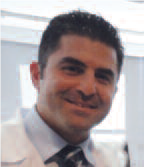
iation’s STR test—which stands for Smile, Talk & Raise both arms—may have erroneously morphed into tongue. “Cranial nerves 9 and 12, the glossopharyngeal and hypoglossal nerves respectively, are associated with the tongue,” Dr. D’Angelo explains. “CN IX receives sensory information from the 1/3 posterior portion of the tongue—the taste buds. CN XII controls the muscles of the tongue. In neuroa
natomy and neurology, we learn that the tongue points to the affected side of the brain. CN XII is located on either side of the medulla oblongata, which is not a typical locale for a stroke.”
John D’Angelo, DO Chariman, Emergency Medicine 908.994.5273
New Hormone Promises Diabetes Breakthrough Harvard researchers have discovered a hormone called Betatrophin, which holds  promise for a more effective treatment of Type 2 Diabetes, which currently affects more than 25 million Americans. In the Harvard study, Belatrophin caused mice to produce insulin-secreting pancreatic beta cells at up to 30 times the normal rate. The new cells produce insulin only when called upon by the body. This offers the potential for natural regulation of insulin, as well as a reduction in the complications associated with diabetes. There is hope that this treatment may also have an impact on juvenile diabetes. It could eventually mean that instead of taking insulin injections three times a day, you might take an injection of this hormone once a week or once a month or—in the best case—maybe even once a year, explains Doug Melton, one of the researchers. “This new hormone offers optimism for researchers lo
promise for a more effective treatment of Type 2 Diabetes, which currently affects more than 25 million Americans. In the Harvard study, Belatrophin caused mice to produce insulin-secreting pancreatic beta cells at up to 30 times the normal rate. The new cells produce insulin only when called upon by the body. This offers the potential for natural regulation of insulin, as well as a reduction in the complications associated with diabetes. There is hope that this treatment may also have an impact on juvenile diabetes. It could eventually mean that instead of taking insulin injections three times a day, you might take an injection of this hormone once a week or once a month or—in the best case—maybe even once a year, explains Doug Melton, one of the researchers. “This new hormone offers optimism for researchers lo

oking to discover a cure for diabetes,” says Dr. Ari Eckman, who heads up the Trinitas Division of Endocrinolo
gy, Diabetes & Metabolism. “It should be noted, however, that this hormone was seen in a mouse model—whether or not this translates to humans is yet to be determined. It is obviously way too early to speculate
if this will work in humans, but certainly this may one day be a novel approach to managing diabetes.”
Ari Eckman, MD Chief of Endocrinology and Metabolism 908.994.5187
Be Mindful About Smoking Take a long, slow deep breath…close your eyes….relax…and get rid of that cigarette! According to the 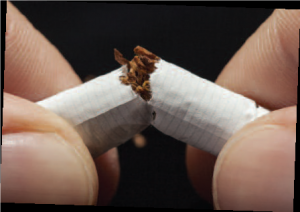 University of Oregon’s Department of Psychology, learning meditation techniques makes it easier for smokers to taper off. Mindful Meditation—a technique that encourages people to relax, focus on the current moment and “go with the flow” of thoughts and sensation—has already been shown to have a positive impact on cold and flu, hot flashes and irritable bowel syndrome. In the Oregon study, 60 people received five hours of either relaxation training or Mindful Meditation training. Among the smokers in the study, there was no difference in the amount the relaxation group smoked. However, the smokers in the meditation group had cut back by 60 percent. Researchers admit that the smoking findings are surprising, and caution that the study was very small. Also, the participants were all college students. On the other hand, none of the subjects were told they were taking part in a smoking study. And the Oregon study found that the brains of the smokers who learned meditation techniques were more active in an area linked to self-control. More work in this area is warranted.
University of Oregon’s Department of Psychology, learning meditation techniques makes it easier for smokers to taper off. Mindful Meditation—a technique that encourages people to relax, focus on the current moment and “go with the flow” of thoughts and sensation—has already been shown to have a positive impact on cold and flu, hot flashes and irritable bowel syndrome. In the Oregon study, 60 people received five hours of either relaxation training or Mindful Meditation training. Among the smokers in the study, there was no difference in the amount the relaxation group smoked. However, the smokers in the meditation group had cut back by 60 percent. Researchers admit that the smoking findings are surprising, and caution that the study was very small. Also, the participants were all college students. On the other hand, none of the subjects were told they were taking part in a smoking study. And the Oregon study found that the brains of the smokers who learned meditation techniques were more active in an area linked to self-control. More work in this area is warranted.





Eight ways to tame your over-the-top teenager.

Photo credit: iStockphoto/Thinkstock
A year ago, I drew upon a couple of decades of hands-on experience to offer up a very personal list of do’s and don’t’s for anyone considering the move to a home office. At the time, I felt I had exhausted my lone area of expertise. However, according to friends and family, I probably had one more article in me. I am a parent of two girls—now 18 and 21—who made it through adolescence relatively unscathed. Or at least, I made it through their adolescence relatively unscathed. They graduated from high school, I didn’t punch out their boyfriends, and as far as I know they did not end up in a Girls Gone Wild DVD. These days, that qualifies me (and my wife) for some kind of gold star. We really did do our best to make sure those wonder years covering 13 to 18 didn’t turn into blunder years. We read books and magazine articles on emotionally intelligent parenting. We discussed and debated parenting tactics out of earshot of our kids. We sought the advice of experts in the field.
We watched all kinds of TV shows—from the ones where therapists help teens and their parents work out knotty issues to the ones that exploit crummy parenting and creepy teen behavior to amp up their ratings. Based on this expansive knowledge base, we went down the cafeteria line and put together a parenting strategy that seemed to have a reasonable chance of success. For example, we resisted the almost constant urge to throttle our teen daughters, and tried instead to engage them in intelligent conversation. In other words, we tried things that didn’t work particularly well. Happily, some things did. And both daughters emerged from the dark tunnel of adolescence with a few door dings, but no major frame damage. My wife and I followed at a safe distance, resisting the temptation to hop in and indulge in back-seat driving. Along the way, we discovered what worked for our family, ourselves and our two very different teenagers. We also learned that there are no shortcuts in that tunnel—you have to make sacrifices, and put in the time, the emotion and the money, sometimes when you think there’s nothing left to give. Presented here, then, is a plan that worked well for at least one family—our family. We didn’t always stick to the plan, but whenever we strayed, we managed to find our way back. It was based on sound professional research mixed in with a little trial and error, and ultimately modified with that dose of reality that sometimes eludes the academics. The take-away is that addressing the challenges of teenage behavior requires an open mind, an open heart, the willingness to keep trying until you get it right…and the humility to realize that thinking you got it right is a sign that something is almost certainly about to go very wrong.
- Praise Positive Behavior Have ever you noticed that the behavior most likely to draw your attention is the behavior you seem to see the most of? There’s a reason for that—we’re reinforcing it. The problem is, all too often we drop the hammer on negative behavior and bad habits, picking transgressions apart in minute detail. Far less frequently, we shower attention on positive behavior, and when we do we aren’t always specific about why it’s positive and how it brightens everyone’s day. In these cases, don’t assume your teenager knows what he or she did right. Praise their positive behavior and explain what makes you happy or proud about it. Start with the small stuff, like picking up dirty laundry or turning off the lights after leaving a room. Offer small rewards, like choosing the music on your next car ride or stopping for an impromptu slice of pizza. Over time, this positive reinforcement will produce steady improvement. Be careful, however, not to go too far and overpraise every little thing. Keep raising the bar. Your kid’s not stupid. Eventually, he or she will catch on.
- Pick Your Battles You can’t rewind adolescence, and there is no restore procedure to turn teenagers back into the kind, considerate children they were 10 years ago. A certain amount of aggravating, self-centered behavior is part of growing up, so the best advice here is don’t sweat the small stuff. Be clear in your own mind between things that are merely annoying and things that are totally unacceptable, like shoplifting or vandalism or drinking and drugs. That other stuff—bad hair, bad makeup, bad clothing, bad music, bad friends, bad grades, bad language, bad time management—is all about your child testing limits (yours and society’s). Stand your ground on issues of safety and security, and do your best to guide them through the superficial stuff without badgering (or strangling!) them.
- Understand the Timeline Teenage behavior is part of a continuum in the maturing process. Just as you would not judge a three-year-old for shoving a Cheerio up his nose, don’t be hypercritical of a 15-year-old who is obsessed with her body image or wardrobe. This is a time of intense social, physical and emotional change. For instance, teenagers honestly believe they are smarter than their parents. So roll with it—don’t take every opportunity to show them how wrong they are. Yes, we know they are idiots when it comes to comprehending cause-and-effect, and they are often incapable of seeing past their own navels. But they have to start navigating life on their own. The best we can do is furnish them with a GPS and hope they don’t swerve into a lake on the road to adulthood. For what it’s worth, remember that, as teens in the 1970s and 1980s, we were operating in a comparatively rule-free environment and most of us emerged in tact.
- Stand Your Ground Setting clear behavioral boundaries and then establishing specific consequences for violating those boundaries is one of the toughest aspects of parenting. Everyone needs to be on the same page when a teenager blows it, and parents must support each other when that inevitable time comes to follow through on the promised punishment. If you threaten a big take-away but then fail to stand your ground, your authority will be seriously undermined. Worse, you may be sending the long-term message that consequences are for other people, not for your kid. Never forget that teenagers are like bloodhounds—they can smell the stink of weakness on a parent. What’s an appropriate punishment for a major violation? Well, what’s most important to your teen? Figure that out and let your child know that it will be taken away. The obvious stuff is phone, computer, video game or TV time. With all the advances in smart phone technology, you can now crush all four by taking away one device! If your teenager is driving, eliminating that privilege can be extremely effective. If you are indulging a special interest or activity—such as a sports team or camp—you can put that out there as a potential punishment, too.
- Set Them Free Teenagers crave independence. They want to make as many of their own decisions as possible, and resent parental interference. Difficult as it may be, parents should be willing to give their adolescent children just enough rope to test their choices and experience the consequences—and then yank them back if necessary. Unfortunately, allowing young people this kind of freedom can

Photo credit: iStockphoto/Thinkstock
result in extremely negative outcomes, such as tangles with the law. However, these experiences also tend to drive home important life lessons that teens might not take on faith from their parents. The big upside of giving teens independence is that, if they make good choices or draw good conclusions, they not only experience a sense of victory, but also know that they are making their parents proud—and that is a huge boost to their self-esteem.
- Walk the Walk Telling teens they need to behave a certain way—and then not living up to that behavior as a parent—is inviting all kinds of trouble. First off, it gives kids the courtroom evidence they need to throw back in your face when you criticize them for dangerous or inconsiderate behavior. Your son may forget to shower for three days, but he’ll remember every last thing you do wrong. Secondly, it completely ignores rule number-one of parenting: Kids do as we do, not as we say. So when you say no cursing, don’t curse around the house. When you say be respectful, don’t belittle your partner or spouse. No one’s perfect, but the more consistent you can be, the greater the impression will be on your teenager.
- Rights, Privileges & Respect These are concepts with which the adult brain often struggles, so it’s no surprise that teens tend to get them really jumbled up. One of the key challenges of parenting is helping adolescents sort out what’s what. If you don’t, you’re likely to end up with an indignant and venomous teenager on your hands. In our society, a child has the right to be sheltered, fed, clothed and schooled. A child also has the right to expect safety, care and compassion in the home, and to civil communication with caregivers. Beyond that, if you ask most parents, everything else is a privilege. Ask a teenager, however, and the list of entitlements is somewhat longer. Most believe they have the right to a phone, a video gaming system, an allowance, transportation, a bedtime of their own choosing and unfettered access to friends. It’s worth a parent’s time to subtly (or, if necessary, not so subtly) delineate between rights and privileges, because rights are something that cannot be taken away, while privileges can—either as a form of behavior modification, or if those privileges are abused. Is respect a right? Parents and kids both might be tempted to answer Yes. But what’s true outside the home carries some weight in the parent-child relationship: Respect is not automatic; it’s something you earn. As parents, we are shocked and offended by disrespectful behavior. What we fail to see is that teenagers are even more wounded when they are belittled by their parents. Sometimes, you just have to sit your kid down and say, “Hey, I’m your parent—I am doing my best to make a home for you, and that buys me some basic respect. We need to see a real effort from you to contribute to this family, and you will have our respect, too.”
- Never Give Up Taming a volatile teenager is no fun. If you’ve ever been tempted to chain your kid to a radiator, don’t worry. You’re

Photo credit: iStockphoto/Thinkstock
hardly alone. Sometimes all you want as a parent is just to get through one day without an explosive or heartbreaking moment. So it’s critical to understand that, when kids enter this dark tunnel, there is truly a light at the other end. If you’re lucky, you can take that journey with them, guide them through, and keep them on the right side of life’s double-yellow line. Just remember to do so in a separate vehicle. And keep several car-lengths between you.
Christian McBride may be the hardest-working man in Jazz. The virtuoso bassist has played on nearly 300 records and has earned three Grammys for his own albums, which number more than a dozen heading into 2014. McBride learned his craft from his father (Lee Smith) and great uncle (Howard Cooper), refined it further at Juilliard, and went on to play with a who’s who of jazz luminaries, including Chick Correa, Sting, Pat Metheny, Diana Krall, David Sanborn, Joe Lovano, Joe Henderson, Freddie Hubbard, Milt Jackson, Benny Green and Ray Brown. All by age 40! McBride and his wife, jazz singer Melissa Walker, live in Montclair, where they lead the Jazz House Kids program and play starring roles at the annual Montclair Jazz Festival. Next March, he will host Jazz Meets Sports at NJPAC, an evening of music and conversation with sports superstars and jazz connoisseurs Bernie Williams and Kareem Abdul-Jabbar. Editor at Large Tracey Smith, who knows a thing or two about jazz herself, talked to McBride about the next step in his already over-the-top career.
EDGE: You’ve made a really impressive transition from in-demand sideman to bandleader. How does that journey work?
CM: As a sideman, when someone hires me for a gig, my first job is to serve the vision of that bandleader. It’s almost like being an actor—if someone calls you in for a role in a movie, you have to thrive within that role. Musicians often say they don’t want to have any limitations or work where there are guidelines. Finding your own place within these guidelines? For me that’s fun! It means I can do this but I can’t do that—or vice versa. Hmmm, let me see what I can find in here. I think that’s how I’m able to still retain my own identity while serving the bandleader.
EDGE: Talk about your work with Chick Correa and Sting.
CM: I’ve had a working relationship with Chick Correa since 1996. And every group I’ve played with him in, it’s quite surreal—he allows me to do whatever I want, do whatever I hear. He wants me to read the music he gives me, but once I get off the paper, I can do my thing! He’s really cool. He trusts me. I’m appreciative and honored by that. Sting, on the other hand, now this is how I think most bandleaders are…or at least should be. When I first started working with Sting, he was only just a little familiar with my playing. He’d heard a couple of the songs I had played on, but mostly it came from reputation. A few of the guys in the band told him if he was looking for a new bass player, then he should look at Christian McBride. When I started rehearsing with him, I realized I had to earn his trust, because we hadn’t played together before. To gain a bandleader’s trust, you must do exactly what they ask you to do—don’t step out of bounds, gain their confidence, and then when they start trusting you more and more, with each performance you get to establish more of your own identity, while serving the bandleader’s vision.
EDGE: Isn’t that still constrictive?
CM: Why would I go on Sting’s gig and start playing all my Ray Brown licks? That isn’t what’s called for. It’s about being selfless and serving the vision. After a few months of playing in his band I was able to throw in—every once in a blue moon—some of my own stuff. Sting would look over and give me a wink, or he would look over and give me a frown (laughs) depending on what lick it was.
EDGE: Now you are primarily a bandleader. Did that take some settling in?

Photo courtesy of Christian McBride
CM: Yes. It’s taken quite some time to feel comfortable being a bandleader all of the time. Over the last, I would say, five or six years, the majority of my time has been dedicated to all of my own projects, my band—Inside Straight—my trio, my big band. Before that, I kind of just dibbled and dabbled at it; most of my time was spent playing with other people, being the sideman. It wasn’t a very good balance of being able to do both. I think most people viewed my being a bandleader as something I did every once in a while, when I wasn’t busy with Pat Metheny or Chick Correa. But now the tide is starting to turn.
EDGE: Both roles demand a certain degree of, as you mentioned, selflessness.
CM: I think that would be the main thread. As a sideman, you have to realize that you are there to serve the vision of the bandleader. Too many musicians are always looking for someone to tell them how great they are, even when it’s not their gig. They somehow want to have a lot of “say so” even though they’re not the bandleader. But that’s not what it is…the greatest musicians I’ve ever been around are very selfless musicians, and as a bandleader you have to be sensitive to your sidemen or collaborators. It’s a democratic process. In order for them to help you carry out your vision, they have to be on your side. You can’t be selfish, you can’t be a mean-spirited slave-driver. That only works for a hot minute, it doesn’t work for the long run (laughs). The band will turn on you at some point.
EDGE: Who do you consider your important influences?
CM: My primary influence when it comes to composition has always been Wayne Shorter. I cannot write like him. Nobody can write like him. In terms of what he writes, and how he writes, he’s always been my number-one hero. But then, there are musicians like Duke Ellington, Oliver Nelson, Chick Correa—they have always been some of my biggest inspirations.
EDGE: When I listen to you, I hear Ray Brown with Jaco Pastorius bass lines. Who are your musical mentors?
CM: Well, those two people you just named are my top two influences of all-time. If I could somehow tell someone what my playing is based on, it would be those two guys, Ray Brown and Jaco Pastorius. Again, particularly with the electric bass, I’m not as well-balanced playing both the acoustic and electric bass, at least publically, as I once did with my old band, The Christian M Band. I would say by the end of next year or early 2015, I want to start doing some work with my fourth group, called A Christian McBride Situation, which is a pretty even balance of acoustic and electric instruments. Ray Brown, Jaco, Ron Carter, Bootsy Collins, they are all my top heroes.
EDGE: 2013 has been a busy year for you.
CM: It has. I’ve had two CD releases already—People Music, with my group Inside Straight was released in May, and my new trio’s CD, called Out Here, was released in August. I also performed at the  University of Maryland a piece I was commissioned to write for the Portland Art Society, The Movement Revisited. It’s a four-part suite dedicated to four major figures of the Civil Rights Movement: Rosa Parks, Malcolm X, Muhammad Ali and Dr. Martin Luther King, Jr., performed by my Big Band and Washington DC’s Heritage Signature Chorale, with spoken word selections by special guests, including civil rights activist and artist Harry Belafonte.
University of Maryland a piece I was commissioned to write for the Portland Art Society, The Movement Revisited. It’s a four-part suite dedicated to four major figures of the Civil Rights Movement: Rosa Parks, Malcolm X, Muhammad Ali and Dr. Martin Luther King, Jr., performed by my Big Band and Washington DC’s Heritage Signature Chorale, with spoken word selections by special guests, including civil rights activist and artist Harry Belafonte.
EDGE: The digital age has certainly changed the recording industry landscape. How has the Internet changed things for you?
CM: It’s been like the Wild Wild West. It’s definitely a new frontier for everyone in the music industry. I think we’re still trying to plant our feet to try to get some stability. It seems like it is affecting everyone across the board, not just jazz musicians. One could argue that it is leveling the playing field, but I think that is only half-true, because what is happening now is that people are crafty and they are finding ways to get around paying for music. That’s not good on any level, because artists have to make a living. I don’t know how we can somehow change the thinking of Americans. I really feel it’s only an American problem, because people have no problem paying for music anywhere else in the world—even people who don’t have a lot of means. They realize the importance of art, but it seems like here it’s, “Why should we pay for music? All these guys are millionaires anyway!” Someone always has this knee-jerk reaction that all musicians are millionaires, or we don’t need the money, or what we do is not really an occupation, it’s a hobby.
EDGE: Who’s on your playlist when you are listening for pleasure?
CM: I really don’t do as much recreational listening anymore. I’m working on so many different projects, that most of my listening is dedicated to that. But James Brown usually dominates any of my musical devices. And there is always plenty of Cannonball Adderley, Ray Brown with Oscar Peterson, plenty of Quincy Jones—especially during his big band stuff. Those are always going to be in my player.
News, views and insights on maintaining a healthy edge.
 Painkiller Overdoses Spiking Among Women A new report from the Centers for Disease Control offers some eye-opening facts on the abuse of painkillers among women. Since 1999, the number of women who have died from a painkiller overdose has increased by a factor of four. “Mothers, wives, sisters, and daughters are dying at rates that we have never seen before,” says Dr. Thomas Frieden, Director of the CDC. Among the more alarming aspects of the report are: 1) On average, 18 women die
Painkiller Overdoses Spiking Among Women A new report from the Centers for Disease Control offers some eye-opening facts on the abuse of painkillers among women. Since 1999, the number of women who have died from a painkiller overdose has increased by a factor of four. “Mothers, wives, sisters, and daughters are dying at rates that we have never seen before,” says Dr. Thomas Frieden, Director of the CDC. Among the more alarming aspects of the report are: 1) On average, 18 women die  from painkiller overdoses in the U.S. every day; 2) More women die from prescription drug overdoses than from car accidents; 3) Some 50,000 women between the ages of 25 and 34 will be taken to U.S. emergency rooms as a result of painkiller overdoses this year. In its report, the CDC recommended that healthcare providers exercise greater caution when prescribing prescription medications—and suggested that states and the federal government could turn this trend around by doing a better job educating women on the dangers of prescription painkillers. “We are seeing an increase in the numbers of women and young people presenting in the emergency room with prescription pain and anxiety medications—many of whom have legitimate prescriptions for a physical or mental health disorder, and others who are accessing prescription meds from others or on the street,” Lisa Dressner confirms. Dressner is Program Director of TRMC’s Psychiatric Emergency Services. “Too often, alternatives to these highly addictive medications are not explored, and primary care or pain management doctors may not fully assess someone’s potential or history of substance abuse.” There is an urgent need, she adds, for more education to consumers around the potential for addiction to commonly prescribed pain meds, and medications for problems related to anxiety or sleep, so that risk for abuse of these medications, and increased depression, withdrawal and suicidality is minimized.
from painkiller overdoses in the U.S. every day; 2) More women die from prescription drug overdoses than from car accidents; 3) Some 50,000 women between the ages of 25 and 34 will be taken to U.S. emergency rooms as a result of painkiller overdoses this year. In its report, the CDC recommended that healthcare providers exercise greater caution when prescribing prescription medications—and suggested that states and the federal government could turn this trend around by doing a better job educating women on the dangers of prescription painkillers. “We are seeing an increase in the numbers of women and young people presenting in the emergency room with prescription pain and anxiety medications—many of whom have legitimate prescriptions for a physical or mental health disorder, and others who are accessing prescription meds from others or on the street,” Lisa Dressner confirms. Dressner is Program Director of TRMC’s Psychiatric Emergency Services. “Too often, alternatives to these highly addictive medications are not explored, and primary care or pain management doctors may not fully assess someone’s potential or history of substance abuse.” There is an urgent need, she adds, for more education to consumers around the potential for addiction to commonly prescribed pain meds, and medications for problems related to anxiety or sleep, so that risk for abuse of these medications, and increased depression, withdrawal and suicidality is minimized.
Lisa Dressner Program Director of TRMC’s Psychiatric Emergency Services 908.994.7152
Good News on HPV Virus Michele Bachman can rest easy. The HPV vaccine does not make young women “mentally retarded.” In fact, according to a report released by the Centers for Disease Control in June, the prevalence of Human Papilloma Virus (HPV) infections has been cut in half since 2006. The Journal of Infectious Diseases reported that researchers were surprised by this result—not because of the vaccine’s effectiveness, but because the rate of vaccination in the U.S. lags far behind  other developed countries. Only a third of American girls have been fully vaccinated; in other countries (including Rwanda!) the rate is closer to 80 percent. HPV causes 19,000 cases of cancer among women in the U.S. each year. It also accounts for 8,000 cases in men, a statistic brought to light by actor Michael Douglas, whose throat cancer was identified as being HPV-related. “The study showed that less than four years later the prevalence of the vaccine strains among young women aged 14–19 years had fallen by 56%,” points out Dr. William Farrer, Associate Program Director and Associate Professor of Medicine of the Seton Hall University School of Health and Medical Sciences at TRMC. “This was despite the fact that in 2010, only 32% of 13–17 year-olds had received the full 3-dose series of vaccine. Rates of HPV infection in older women had not fallen, probably reflecting the fact that they were not the target group for the vaccine.The researchers also reported that ‘Sexual behavior among females aged 14–19 years overall was similar in the two periods.’ This should reassure opponents of the HPV vaccine who expressed concern that somehow use of the vaccine would encourage promiscuity.”
other developed countries. Only a third of American girls have been fully vaccinated; in other countries (including Rwanda!) the rate is closer to 80 percent. HPV causes 19,000 cases of cancer among women in the U.S. each year. It also accounts for 8,000 cases in men, a statistic brought to light by actor Michael Douglas, whose throat cancer was identified as being HPV-related. “The study showed that less than four years later the prevalence of the vaccine strains among young women aged 14–19 years had fallen by 56%,” points out Dr. William Farrer, Associate Program Director and Associate Professor of Medicine of the Seton Hall University School of Health and Medical Sciences at TRMC. “This was despite the fact that in 2010, only 32% of 13–17 year-olds had received the full 3-dose series of vaccine. Rates of HPV infection in older women had not fallen, probably reflecting the fact that they were not the target group for the vaccine.The researchers also reported that ‘Sexual behavior among females aged 14–19 years overall was similar in the two periods.’ This should reassure opponents of the HPV vaccine who expressed concern that somehow use of the vaccine would encourage promiscuity.”
William Farrer, MD Department of Medicine, Infectious Diseases Division 908.994.5455
 Air Pollution Linked to Sleep Disorders in Children While we watch the Arab Spring unfold in Egypt in dramatic fashion, some dramatic health news has come out of that country that is relevant right here in New Jersey. In July, University of Cairo researchers announced the results of sleep study on school-age children, which shows a link between air pollution and sleep disorders. The 276 children in the study exhibited significant disorders of initiating and maintaining sleep, and excessive
Air Pollution Linked to Sleep Disorders in Children While we watch the Arab Spring unfold in Egypt in dramatic fashion, some dramatic health news has come out of that country that is relevant right here in New Jersey. In July, University of Cairo researchers announced the results of sleep study on school-age children, which shows a link between air pollution and sleep disorders. The 276 children in the study exhibited significant disorders of initiating and maintaining sleep, and excessive  somnolence when exposed to PM10 (particulate matter smaller than 10 micrometers) in the air. PM10 particles can settle in the lungs and cause health problems. Larger particles are typically filtered by the nose and throat. In treating the pediatric population at the Trinitas Comprehensive Sleep Disorders Center, Vipin Garg, MD, Director of the Center notes that, “Small particles or large particles of pollution can irritate the airways of children, especially those who have large adenoids. Children who have to breathe through their mouths because of enlarged adenoids bypass the normal filtering process of the nose and that can have an irritant effect on both the upper and lower airways. This may result in a significant sleep disturbance especially if sleep is already compromised. Also lower airway irritation can lead to asthma-like symptoms.”
somnolence when exposed to PM10 (particulate matter smaller than 10 micrometers) in the air. PM10 particles can settle in the lungs and cause health problems. Larger particles are typically filtered by the nose and throat. In treating the pediatric population at the Trinitas Comprehensive Sleep Disorders Center, Vipin Garg, MD, Director of the Center notes that, “Small particles or large particles of pollution can irritate the airways of children, especially those who have large adenoids. Children who have to breathe through their mouths because of enlarged adenoids bypass the normal filtering process of the nose and that can have an irritant effect on both the upper and lower airways. This may result in a significant sleep disturbance especially if sleep is already compromised. Also lower airway irritation can lead to asthma-like symptoms.”
Vipin Garg, MD Director, Trinitas Comprehensive Sleep Disorders Center 908.994.8880
 Walking the Walk While the medical profession has long promoted the benefits of daily exercise, a new study out of the Middle East pinpoints how short, brisk walks taken after meals are an effective way to diminish the risk of developing Type 2 diabetes. The results, published in the latest issue of Diabetes Care, focus on how post-meal strolls reduce blood sugar levels. “Blood sugar levels are the highest after meals and as we age our pancreas is less effective in releasing insulin, a hormone that helps lower blood sugar,”
Walking the Walk While the medical profession has long promoted the benefits of daily exercise, a new study out of the Middle East pinpoints how short, brisk walks taken after meals are an effective way to diminish the risk of developing Type 2 diabetes. The results, published in the latest issue of Diabetes Care, focus on how post-meal strolls reduce blood sugar levels. “Blood sugar levels are the highest after meals and as we age our pancreas is less effective in releasing insulin, a hormone that helps lower blood sugar,”  explains Dr. Mahmoud Ali Zirie, who ran the study out of Qatar. “This leads to higher blood sugar that can increase the risk of diabetes. A short walk two hours after meals can help normalize blood sugar levels. To achieve maximum health benefits walking should be moderate intensity. In other words, it needs to be faster than a stroll and brisk enough to raise your heart rate.” Those who are new to this type of exercise should begin slowly, stay hydrated and avoid excessive heat, and build toward a regular and rigorous regimen. Kathleen McCarthy, RN, a Certified Diabetes Educator at Trinitas, offers these tips: “Whether you have diabetes or you are trying to keep diabetes at arm’s length, you will benefit from a regular exercise regimen of 30 minutes a day, five days a week, or more. Short brisk walks, two hours after a meal, improve post-prandial (after meal) glucose readings. Walking also improves circulation, heart and lung function, and releases endorphins which help control of stress and pain. As you build muscle mass, your metabolism will increase which then gives you more energy and will lead to weight loss over time. The benefits of aerobic exercise last up to 12 hours after exercise. Exercise is a key ingredient to improve or maintain optimal health.”
explains Dr. Mahmoud Ali Zirie, who ran the study out of Qatar. “This leads to higher blood sugar that can increase the risk of diabetes. A short walk two hours after meals can help normalize blood sugar levels. To achieve maximum health benefits walking should be moderate intensity. In other words, it needs to be faster than a stroll and brisk enough to raise your heart rate.” Those who are new to this type of exercise should begin slowly, stay hydrated and avoid excessive heat, and build toward a regular and rigorous regimen. Kathleen McCarthy, RN, a Certified Diabetes Educator at Trinitas, offers these tips: “Whether you have diabetes or you are trying to keep diabetes at arm’s length, you will benefit from a regular exercise regimen of 30 minutes a day, five days a week, or more. Short brisk walks, two hours after a meal, improve post-prandial (after meal) glucose readings. Walking also improves circulation, heart and lung function, and releases endorphins which help control of stress and pain. As you build muscle mass, your metabolism will increase which then gives you more energy and will lead to weight loss over time. The benefits of aerobic exercise last up to 12 hours after exercise. Exercise is a key ingredient to improve or maintain optimal health.”
Kathleen McCarthy, RN Certified Diabetes Educator 908.994.5490
 Mild Depression and Alzheimer’s A recent aging study conducted by researchers in the U.S. and Asia has found that the onset of Alzheimer’s Disease appears to be accelerated by depression. The study suggested that individuals with depressive symptoms progressed from mild cognitive impairment to full-blown Alzheimer’s at a much faster rate than those who did not exhibit signs of depression. Indeed, depression doubled the risk of developing Alzheimer’s in this particular study. These findings have opened
Mild Depression and Alzheimer’s A recent aging study conducted by researchers in the U.S. and Asia has found that the onset of Alzheimer’s Disease appears to be accelerated by depression. The study suggested that individuals with depressive symptoms progressed from mild cognitive impairment to full-blown Alzheimer’s at a much faster rate than those who did not exhibit signs of depression. Indeed, depression doubled the risk of developing Alzheimer’s in this particular study. These findings have opened  up a number of debates about what actually triggers the cognitive decline. However, it strongly suggests that decisive steps to intervene or mediate depression among people at risk for Alzheimer’s need to be taken. “Occasionally, depression in the elderly, even in the absence of dementia, has been known to result in impairment of cognitive functions,” adds Dr. Anwar Y. Ghali, Chairman of Psychiatry at Trinitas. “Especially the memory, in a condition referred to as ‘depressive pseudo dementia.’ Hence, one would expect that this might occur at a higher rate with patients already diagnosed with Alzheimer’s. Therefore, physicians should always evaluate Alzheimer’s patients for the possibility of a co-morbid depression. With adequate treatment of depression, patients should be relieved of suffering and also experience reduced possibility of suicide—a complication of depression that occurs at a higher rate with the elderly, especially in males and particularly for those suffering from an additional illness.”
up a number of debates about what actually triggers the cognitive decline. However, it strongly suggests that decisive steps to intervene or mediate depression among people at risk for Alzheimer’s need to be taken. “Occasionally, depression in the elderly, even in the absence of dementia, has been known to result in impairment of cognitive functions,” adds Dr. Anwar Y. Ghali, Chairman of Psychiatry at Trinitas. “Especially the memory, in a condition referred to as ‘depressive pseudo dementia.’ Hence, one would expect that this might occur at a higher rate with patients already diagnosed with Alzheimer’s. Therefore, physicians should always evaluate Alzheimer’s patients for the possibility of a co-morbid depression. With adequate treatment of depression, patients should be relieved of suffering and also experience reduced possibility of suicide—a complication of depression that occurs at a higher rate with the elderly, especially in males and particularly for those suffering from an additional illness.”
Anwar Y. Ghali, MD, MPA Chairman, Psychiatry 908.994.7454
 Landmark Diabetes Study Completed The recently completed Look AHEAD study by the University of Pittsburgh has brought into question the value of lifestyle intervention programs for overweight and obese Type 2 diabetes patients. The study covered more than 5,000 people at 16 clinical centers across the country, over more than a decade. One group in the study followed an aggressive program of weight management and increased physical activity. The other was only provided with health information and support related to diabetes. In terms of strokes and heart attacks, there was no significant difference between the two groups. The biggest difference between the groups was in the area of weight loss. The information and support group lost relatively little weight, while the intervention group lost 8.7 percent of their body weight and had excellent success keeping it off. A 5 percent weight loss is considered clinically significant, particularly in the controlling of cholesterol, blood pressure and blood sugar. “While the findings from the Look AHEAD study did not support that
Landmark Diabetes Study Completed The recently completed Look AHEAD study by the University of Pittsburgh has brought into question the value of lifestyle intervention programs for overweight and obese Type 2 diabetes patients. The study covered more than 5,000 people at 16 clinical centers across the country, over more than a decade. One group in the study followed an aggressive program of weight management and increased physical activity. The other was only provided with health information and support related to diabetes. In terms of strokes and heart attacks, there was no significant difference between the two groups. The biggest difference between the groups was in the area of weight loss. The information and support group lost relatively little weight, while the intervention group lost 8.7 percent of their body weight and had excellent success keeping it off. A 5 percent weight loss is considered clinically significant, particularly in the controlling of cholesterol, blood pressure and blood sugar. “While the findings from the Look AHEAD study did not support that  engagement in a weight-loss intervention was effective for reducing the onset of cardiovascular disease incidence or mortality, this does not mean that overweight adults with diabetes should not lose weight and become more physically active,” says John Jakicic of the Department of Health and Physical Activity in Pitt’s School of Education. Dr. Ari Eckman, Chief of Endocrinology and Metabolism at Trinitas, adds that there is an overwhelming amount of evidence from this study to date that has shown that weight loss and physical activity were associated with numerous other health benefits: “While weight loss alone was not shown to significantly decrease this incidence in the recent Look AHEAD study, there is strong support from numerous studies supporting the benefits of weight loss and physical activity for many other health benefits. Further studies are recommended to determine the full effect weight loss has on cardiovascular disease prevention. It is still strongly recommended for people with diabetes who are overweight or obese to lose weight and maintain a healthy lifestyle.”
engagement in a weight-loss intervention was effective for reducing the onset of cardiovascular disease incidence or mortality, this does not mean that overweight adults with diabetes should not lose weight and become more physically active,” says John Jakicic of the Department of Health and Physical Activity in Pitt’s School of Education. Dr. Ari Eckman, Chief of Endocrinology and Metabolism at Trinitas, adds that there is an overwhelming amount of evidence from this study to date that has shown that weight loss and physical activity were associated with numerous other health benefits: “While weight loss alone was not shown to significantly decrease this incidence in the recent Look AHEAD study, there is strong support from numerous studies supporting the benefits of weight loss and physical activity for many other health benefits. Further studies are recommended to determine the full effect weight loss has on cardiovascular disease prevention. It is still strongly recommended for people with diabetes who are overweight or obese to lose weight and maintain a healthy lifestyle.”
Ari Eckman, MD Chief of Endocrinology and Metabolism 908.994.5187

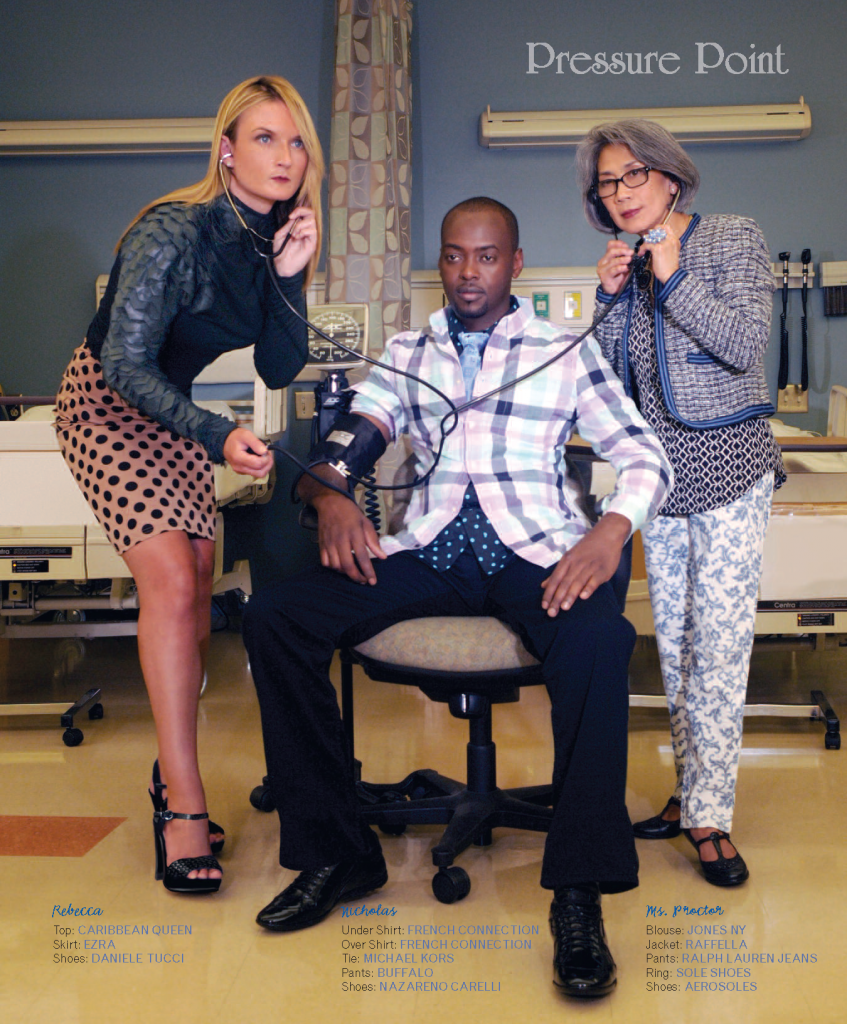
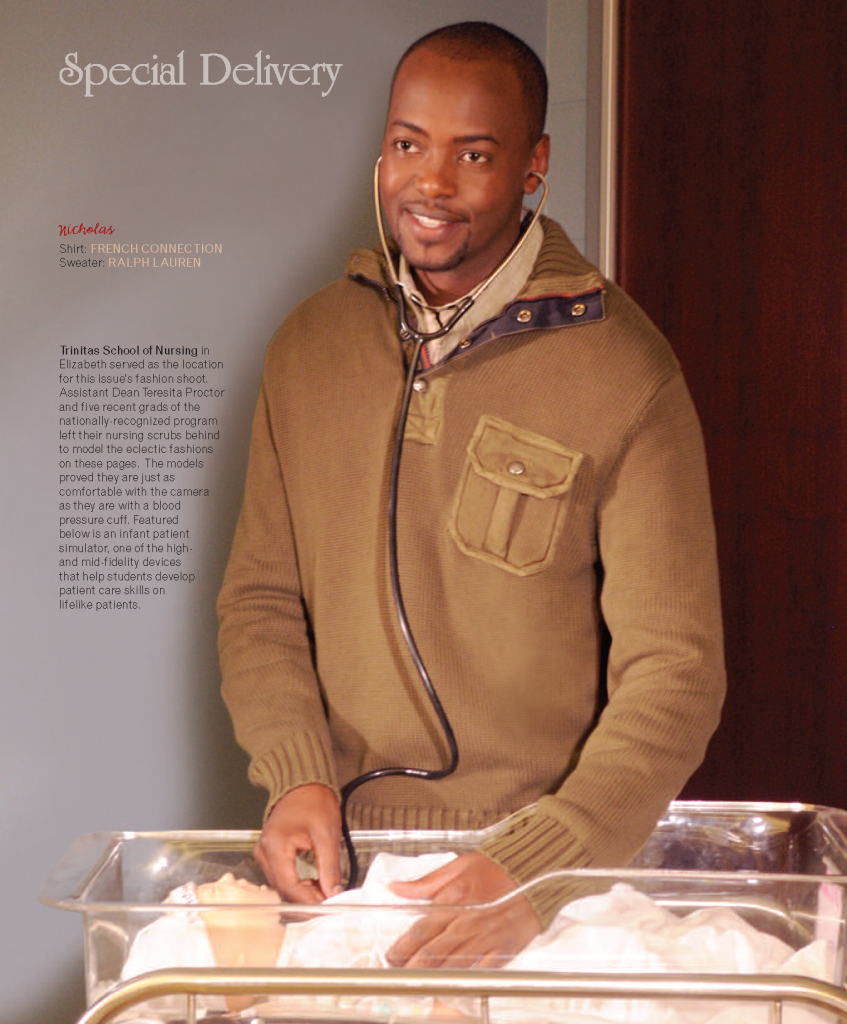


New Jersey has been good to Terence Winter. The Garden State furnished him with the inspiration and settings for two of the most iconic series in television history. Winter was a writer and executive producer for The Sopranos, and the creator of Boardwalk Empire. The Brooklyn born ex-lawyer sat down with EDGE Editor at Large Tracey Smith to talk about the two shows and their protagonists, reveal a nugget or two about the upcoming Boardwalk Empire season, and his upcoming film, The Wolf of Wall Street. What’s the key to writing a great series about crooks? Honesty…what else?
EDGE: Explain how you were able to transition so easily from The Sopranos to Boardwalk Empire?
TW: It might have looked easy but it wasn’t. There was a lot of research involved for Boardwalk that I didn’t need to do on The Sopranos. For example, on The Sopranos, because it was contemporary, I didn’t need to look up pop culture references, I knew the way people spoke, acted, and dressed. For the 1920s, it’s a whole different ball game. I needed to learn about World War I, I needed to learn about the Temperance Movement, I needed to learn about the year women got the right to vote—I needed to put myself in the mindset of characters who were born in the 19th century. So colloquialisms, what books did they read, what movies were out then required months and months of research before I was even able to begin to write the pilot. So even though they are a similar genre, and the characters cover some of the same territory psychologically, it’s almost a hundred years earlier, so the prep work was massive.
EDGE: One of the first things Tony said on The Sopranos was that he felt like he was coming in on the end of something. Steve Buscemi’s character in Boardwalk Empire, Nucky Thompson, is right there at the start of something.
TW: Right. Prohibition was the single event that made organized crime possible. That, more than anything else, was the impetus for criminals to start working together to make money. The interstate trafficking of alcohol made millionaires of criminals overnight, and enabled them to then infiltrate other businesses, and ultimately become organized throughout the country.
EDGE: How do Nucky and Tony compare as protagonists?
TW: In terms of their psychology, they both at their heart are depressed people, sort of searching for something that will make them happy. They are both very smart, both natural leaders, and both are ruthless. Tony’s fatal flaw is that he has a conscience. If he were more of a true sociopath, he wouldn’t pass out, wouldn’t have panic attacks, and wouldn’t care. Nucky, I think, is the same way. We’ve explored a little bit of the psychology of Nucky. We learn by the end of the first season that his wife lost a child very early on, and he is still haunted by that, and that he had a difficult relationship with his father. He’s trying to repair a broken childhood and to recreate a happy family life that he can’t quite seem to replicate.
EDGE: How did Steve become your Nucky?
TW: I’ve been a fan of Steve’s since a movie he did in the 90s called In the Soup. The moment I saw him I was just fascinated with this guy. I was lucky enough to get to know him when he directed a few episodes of The Sopranos that I wrote, and we became friends. Then, of course I got to work with him as an actor when he portrayed Tony’s cousin. I’ve seen everything that Steve’s ever done as an actor. I’ve seen him portray every possible color of human emotion, back and forth, every which way. So for me there was never a question of whether or not he could be convincing as Nucky. When we started to cast for the show, Martin Scorsese and I were talking about who is going to play the lead role. Our Nucky is based on a real person, Nucky Johnson. We fictionalized him as Nucky Thompson, so he’s a version of that person. But we realized since nobody really knew what the real Nucky looked like anyway, it didn’t really matter who we cast in terms of whether or not they looked similar. So Marty said, “Well, let’s just pick an actor that we both like. Who are people you want to work with?” I’m pretty sure it was me that said, “What about Steve Buscemi?” He jumped on it and said, “Oh my God, I love him.” About a week later, Marty called me up and said, “I can’t stop thinking about Steve Buscemi.” I told him I couldn’t either, and he said, “Let’s do it.” HBO was on board—their feeling was Wow, what an interesting choice. That was it. We were off to the races.
EDGE: Why didn’t you use Nucky’s real surname?
TW: I wanted the opportunity to take my Nucky into places where the real Nucky might not have gone. For example, I’m pretty certain the real Nucky didn’t kill anybody. I’m pretty certain he didn’t embrace gangsterism the way our Nucky does. Fictionalizing him gave me artistic latitude and allowed me to sleep at night.
EDGE: How difficult is it to develop so many characters simultaneously?
TW: It’s a massive juggling act. There’s a lot of plotting out, there’s a lot of characters on the show, we’ve got action taking place in several different cities—it’s a big, big, chessboard of characters. That’s the work that goes on in the Writer’s Room. It all starts with “What if?” If suchand- such happened, what would the result of that be? What’s the fallout from that? Where do we want to end up? I’ll come into the season and have a pretty good idea of where I want things to end by episode twelve, sort of like a roadmap. We’re gonna drive from New York to California—alright, well, how do we get there? Those are the story beats that bring us to various places, and it takes a lot of sitting around the table and talking and banging your head against the wall, and plotting, and figuring it out. Eventually, it all works, but it’s a big, big, juggling act.
EDGE: And now you have two new characters to blend in.
TW: Yes. Jeffrey Wright plays a character this season called Valentin Narcisse. He is a Doctor of Divinity who also happens to be the most powerful gangster in Harlem. He crosses paths with Nucky and Chalky in Atlantic City, and that is about as much as I can tell you at this point. If you know anything about Jeffrey and his work, he’s a phenomenal actor, just incredible. We were so thrilled to be able to work with him and have him on the show. The same with Ron Livingston. I’ve been a fan of Ron’s for years and years. He’s so versatile. His work on Band of Brothers, Office Space—I mean, he’s one of these actors that can do comedy, drama, anything in between. He becomes an acquaintance of Jillian Darmody’s, and has a really interesting storyline as well. I’m really excited about both of those guys.
EDGE: A lot of people were shocked when you killed off Jimmy Darmody at the end of season two, just as they were when Tony killed Christopher in The Sopranos. What’s involved in the decision that a major character has to go, especially a protégé?
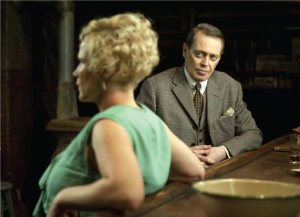
Photo courtesy of HBO
TW: First and foremost, I try to write the show truthfully. I try to avoid making decisions based on what would be the popular choice, what the audience would want me to do, what the conventions of television would be, which is: You don’t kill your second lead on the show, a beloved character. As season two was playing out, it became really clear to me that if we were going to tell this story honestly, Nucky would kill this guy…and he would kill him immediately. If I were watching this and he at the last minute changed his mind and Jimmy got off with a stern reprimand, I’d say, “This is not true, this is a TV show!”
EDGE: It is a TV show.
TW: But I want it to feel real. I think over 60 or 70 years of TV history, we’ve sort of lulled our audience into a sense of complacency. People say, “Oh, well, they’re obviously not gonna kill this guy, I know it looks like they are, but they won’t, because he’s one of the stars of the show. So, of course, people couldn’t believe when we did it, which made me even more certain I’d made the right decision. The louder the uproar, the louder the outcry, the more I was convinced we did the right thing.
EDGE: You have some interesting projects coming up with Leonardo di Caprio, Martin Scorsese and Bobby Cannavale.
TW: In November, Wolf of Wall Street opens. That’s, as you said, directed by Martin Scorsese and stars Leonardo di Caprio. It’s the true story of a stockbroker named Jordan Belfort who, in the 90’s, made tens of millions of dollars a year as the head of his own stockbrokerage firm. He found a way to sell very inexpensive stocks to rich people. He sort of cracked the code, and he and hundreds of young brokers working for him made a fortune. It was just an incredible roller coaster, a wild ride with incredible amounts of money and drugs. Leo is terrific in it and, of course, we’ve got the master, Martin Scorsese, directing. I’m also working on another series with Martin Scorsese for HBO, this one involving Mick Jagger. It’s set in the world of rock music in 1973 New York City, starring Bobby Cannavale as a cocaine-fueled, A&R executive for a record company. That was the year that punk, disco and hip hop were all invented in and around New York City, a time of great change, of great upheaval in the city. I’m really, really excited about that project. Hopefully, the pilot will be directed in the early part of next year, and we’ll go into series right after that.
EDGE: Cannavale was like a bull in a china shop on Boardwalk Empire.
TW: Oh yeah! There was nobody better to play the Gyp Rossetti role than Bobby. He was great. I think we had one conversation about who that character is and what motivated him, and Bobby got it immediately and ran with it and became Gyp Rosetti. It’s so funny, because nothing could be further from the real guy. Bobby is just the sweetest, funniest, most gentle person in real life, and as an actor he can sort of give you anything. He can turn into Gyp Rosetti on a dime and then go back to being himself again—it was pretty amazing to watch.
EDGE: How many more seasons?
TW: I would love to do seven seasons all together. We’re starting down the homestretch in season four; whether or not we’re fortunate enough to get to do them remains to be seen. It all really is going to depend on what the public’s appetite is for this show, and HBO’s, of course. I would love to do three more years, I think that could take us to the point in Nucky’s story, and the point in history that I’d like to get us to. Hopefully, we’ll get the chance to do that.
EDGE: Are you a nostalgic person?
TW: Very much so. I love history. I am the family’s historian. I’m the one who archived all of the family photos and films, the genealogy and all that stuff. I love the idea of leaving that behind for my children, and grandchildren, and their children. I’d give my left arm just to read about what my great-great-grandfather’s day was like. “What did you do, where did you go, who did you talk to?” That stuff is fascinating to me.
Editor’s Note: There are no short conversations once Tracey Smith gets you talking. For (a lot) more on Nucky, Chalky, Margaret, Richard and Van Alden—and the inside story on the brilliant “Pine Barrens” episode of The Sopranos—visit edgemagonline.com and read the rest of our Q&A with Terence Winter.
Five challenges facing New Jersey education

Photo credit: iStockphoto/Thinkstock
Most school administrators wouldn’t trade their job for anyone else’s. That being said, most wouldn’t wish their job on their worst enemy. Whether calling the shots in a public, private, faith-based or boarding school, the people who run New Jersey’s halls of education are engaged in a never-ending game of Whack-A-Mole: As soon as one problem is addressed, two more always seem to pop up. None of these problems, it is worth noting, is simple. Nor is much in the way of extra help available to deal with them. In fact, since the 1980s, the number of teachers in New Jersey has grown by nearly a third. The number of administrators during that time has gone up a mere two percent. New Jersey’s public schools handle about 1.4 million kids in a given year, and their budgets make up the largest state-funded operation.
Our students rank high nationally in reading, writing and arithmetic, and we have the best high-school graduation rate in the country. New Jersey’s private schools rank among the best in the nation, too. Even so, our schools—all of our schools—have had to face significant challenges in the early part of the 21st century. Some are obvious, like budgeting. Everyone could use more money, from language arts instructors to librarians to lunch ladies. At the same time, budget reformers are looking for creative ways to slash school budgets, which in some places are driving property taxes up so high that many residents can’t afford to stay in the towns they’ve lived in for generations. In these pages, we’ll veer off the beaten path a bit and look at five topics that you either don’t hear much about, or don’t think about too much when you do hear about them. All are on the daily schedule for school administrators, and present some of their most difficult challenges.
TEACHER PERFORMANCE This is an incredibly complex issue. Who are the best teachers? Are they the ones who consistently turn out superb test-takers? Are they the ones whose students come back to visit 10 and 20 years later? Are they the ones who take thankless jobs in the most troubled school systems? These questions are not only relevant from a quality-of-education standpoint. With more and more discussion about the creation of incentives for great teachers—and a mechanism for getting rid of some lousy ones—there will be a need for some quantifiable measurements. And those measurements will have to include metrics that take into account the challenges each educator faces in his or her classroom. That is why all eyes are focused on the Newark school system, which famously received a pile of Facebook stock from Mark Zuckerberg three years ago.
In the new contract negotiated with city teachers at the end of 2012, there is a provision for merit pay. Teachers rated as “highly effective” can now pocket $5,000 in bonus money, which comes right out of the Facebook fund. Teachers in the more troubled schools can earn even more, as can math and science teachers. Teachers rated as “effective” will receive an agreed-upon pay raise every year they maintain that standing. Newark’s teachers are represented by the American Federation of Teachers, which negotiated the bonus terms. Most public educators in the state are represented by the New Jersey Education Association, which to this point has stood firmly against a bonus scheme. Needless to say, the NJEA will come under pressure to consider teacher bonuses if the Newark experiment is a success. What does success look like? More money for outstanding teachers, a fair wage for competent ones, and perhaps a way to ease out chronic under-performers.
SECURITY In the wake of the New-town tragedy, every school in the state had to reexamine its readiness and vulnerability in emergency situations. The process was expensive, time-consuming and eye-opening. For a while, everyone was nattering about armed guards in the hallways and even armed teachers in the classrooms. It appears that cooler heads have prevailed. The fact of the matter is that armed intruders are incredibly rare; a far more likely emergency scenario is an out-of-control parent, power failure or dangerous weather event. The bad news is that most New Jersey schools lack adequate staff training on the procedures needed to deal with these emergencies. There is actually an Office of School Preparedness and Emergency Planning. As you might imagine, its inspectors have been very busy since the Sandy Hook shootings. Some of their visits are scheduled, while others are unannounced. The goal is not to “catch” public schools unprepared, but to make sure that they follow a set protocol for lock-downs and other safety drills. The state has always had relatively strict drill requirements, so it has been more of a fine-tuning process than an overhaul.
Private schools are a different matter. They tend to operate more openly to project a warm and welcoming feeling to current and prospective parents. Many of these schools have drop-off and pick-up “traditions” that they are reluctant to change, even when they might compromise security. In some schools, parents could slap a Visitor sticker on and roam the halls without attracting a second look. Well, this situation has changed dramatically in the last year. Parents who were once charmed by a feeling of openness have started looking at their schools with a more critical eye. As a result, most private schools—at considerable expense—have undergone security audits, and are now making substantial changes to their physical spaces, technology, and visitor policies. These changes have to be paid for. In some cases, schools will dip into their endowments. In others, there will be a noticeable bump in tuition.
HOMEWORK The point of homework is not just to educate students outside the classroom. It helps them develop time-management skills and teaches them lessons in accountability they will need to learn before moving on to college or into the workforce. The challenge public schools face is that students who will not (or cannot) complete their homework assignments fall behind the rest of the class. They become disinterested or disenchanted or disruptive. Over the course of a semester, depending on the school system, a teacher who is tough about homework is likely to find a large portion of the class far behind by the time final grades are given. In subjects where testing is used to measure a school’s success (and by extension, a teacher’s effectiveness), everyone loses. So what’s a teacher to do? In many instances, a large portion of class time is now devoted to getting homework done!
This is the only way to ensure that every student is on the same page. Unfortunately, this limits the amount of material that can be covered in class. It is also creating a generation of kids with a lot of un-monitored after-school time to kill, which isn’t necessarily a good thing. The challenge for private schools where homework is concerned often comes down to blow-back from parents about too much. Above 5th or 6th grades, most private schools have a policy limiting homework to no more than 15 to 30 minutes per subject. Of course, if three classes give a half-hour each, a project is due in a fourth class, and a student needs to study for a quiz or exam in a fifth class, the result can be a meltdown. And guess who deals with that? The parents…who are paying thousands of dollars a year (sometimes tens of thousands) in tuition. Many feel that this buys them the privilege of not having to crack the whip on homework assignments.

Photo credit: iStockphoto/Thinkstock
RECESS (aka GYM) Recess—or free time for physical activities—has long been a tradition in both public and private education. Researchers agree that its value includes the development of cognitive skills outside the classroom environment, including cooperation, teamwork and communication. Recess has also been shown to have a direct link to improved academic performance. And, of course, activity during the school day is one way of addressing the obesity issue. The problem is that the number of schools with a structured PE curriculum is shrinking—in some cases for budgetary or manpower reasons, in others because of liability concerns.
In schools that need to improve their measurable academic success, outdoor time has actually been cancelled to give students extra time to prep for tests. Those schools that continue to schedule recess or gym classes have in many cases devolved into little more than active socializing. Indeed, at some schools, “walking and talking” constitutes an adequate amount of physical activity. A recent study estimated that two in five schools have either eliminated recess or reduced it. In lower-income districts, the cuts have been even more dramatic. The situation has become so distressing that, this past year, Shirley Turner, a state senator representing portions of Mercer and Hunterdon Counties, introduced a bill requiring public schools to provide a daily recess period, but only through fifth grade.
BULLYING In the last five years, national attention has been focused on the issue of bullying in schools. It is on the rise nationwide, and in New Jersey, too. The rapid growth of social media has certainly added fuel to what was a smoldering fire. So, too, has the focus on confrontation in the reality shows that young people watch. Schools have combated this growing problem as best they can, including a stronger anti-bullying law that went into effect in New Jersey during the 2011–12 school year. That law compelled schools to designate an Anti-Bullying Coordinator, who must report every incident. Prior to the 2011 legislation, reports of school bullying had risen sharply, by 15 to 20%, over a three-year period, according to the state’s Department of Education. Critics of the new rule claimed that the stricter reporting requirement might send the bullying numbers soaring.
However, this doesn’t appear to be the case. In some districts, bullying incidents actually fell. In others they remained fairly consistent. In a few, they spiked. Who are the bullies? About a third of reported incidents involve seventh- and eighth-graders. A quarter occur among ninth- and tenth-graders. Fewer than 1 in 20 of these incidents was linked to racial or religious bias, so basically it’s kids being jerks. Some have posited that the rise in bullying may be linked to the punishment now meted out in public schools for physical violence. In the old days, standing up to a bully meant punching him in the mouth—or at least making yourself a hard target. Now that response would carry an automatic suspension. Others point out that if a bully is using social media as a weapon, a punch in the mouth isn’t even an option anymore. The notion that bullying is less of a problem in private schools may be accurate, but it is not supported by any hard numbers. Those institutions are not compelled to report bullying, and each sets its own policy. To be certain, bullying does occur in New Jersey’s private, faith-based and boarding schools. It may be more subtle or sophisticated, and some cases may involve influential families, so administrators must tread lightly before dropping the hammer on a bully.
Editor’s Note: What might this same article include a year from now? Some trends to keep an eye on are New Jersey’s adoption of national Common Core standards. New York adopted them recently and saw its test scores fall. It will also be interesting to watch the development of Governor Christie’s Regional Achievement Centers, which are meant to be a resource for teachers and parents, but thus far have been underutilized. And finally, a debate may be on the horizon regarding the skyrocketing costs of special education.
Of note to teachers and parents: TRMC’s Department of Behavioral Health & Psychiatry produced Step-Up, Take Action: When Does a Child Need Help? Log onto edgemagonline.com for a free PDF version in English or Spanish.











